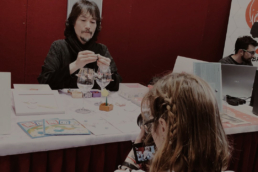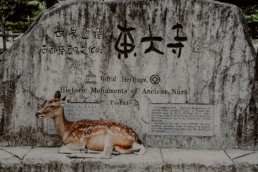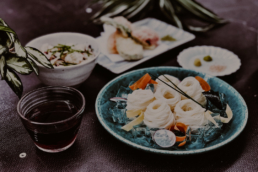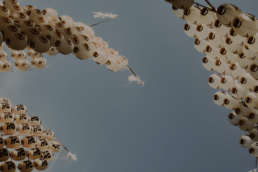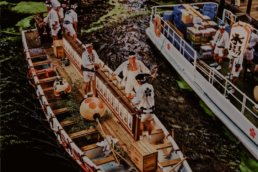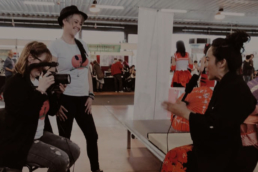Japan History: Shimazu Takahisa
Shimazu Takahisa was born May 28, 1514, son of Shimazu Sagami no kami Tadayoshi (1492-1568), adopted by Shimazu Katsuhisa. He became the lord of Kagoshima after Katsuhisa's escape in 1526. He conquered the aforementioned city in 1536 and extended his authority throughout the province of Satsuma.
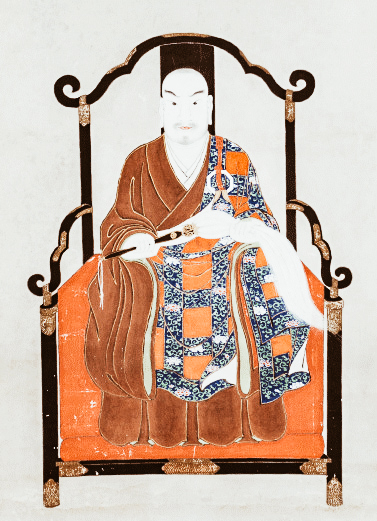
photo credits: wikipedia.org
He was one of the first daimyō to employ firearms in battle during the siege of Kajiki in the province of Ōsumi in 1549. In that same year, he welcomed Francis Xavier to Kagoshima. He granted Jesuit protection to spread Christianity in his domain, later withdrawn under pressure from local Buddhist monks. Takahisa also had diplomatic relations with the Ryūkyu Kingdom.

photo credits: pinterest.com
15th head of the Shimazu clan, he supervised the transfer of the clan's headquarters from Shimizu castle to Uchi castle in 1550 when he sent Ijūin Tadaaki to Shimizu to suppress the rebellions and secure control of the Shimazu over the province. In 1554 his troops won against the Hishikari, Kamō and Ketō clans during the siege of Iwatsurugi. His son Shimazu Yoshihisa later completed the defeat of these clans and secured control of the Shimazu over the rest of the Satsuma province.
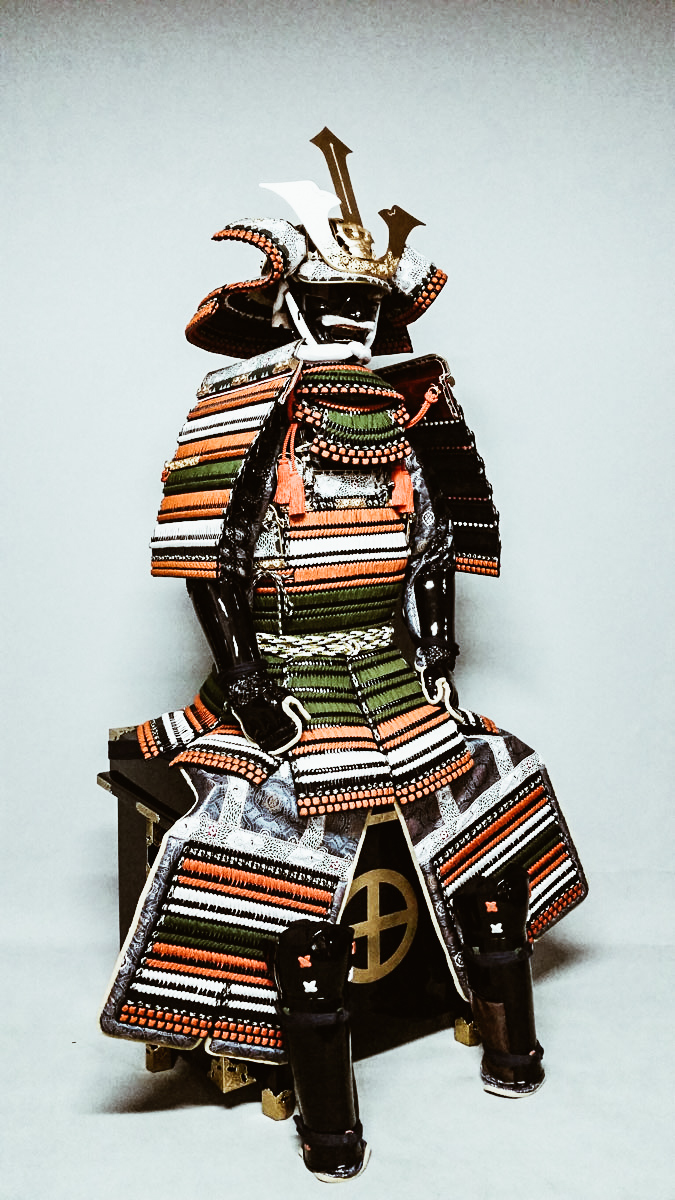
photo credits: global.rakuten.com
He officially retired in favor of Yoshihisa in 1566 and in 1569 the Iriki-in and Tōgō clans were defeated and he secured control over Satsuma. The following year he rejected a naval attack by members of the Kimotsuki, Ijiki and Nejime clans. He died on 15 July 1571.
His idea of promoting relations with foreign people and countries is very important.
His sons were Yoshihisa, Yoshihiro, Iehisa and Toshihisa.

photo credits: wikipedia.org
Bringing Japan to Italy: episode 09 - Codice Bianco
A few months ago, in conjunction with the Novegro comics festival, we had the opportunity to interview Codice Bianco. For this ninth episode of 『Bringing Japan to Italy』, the artist specializing in sculptures and origami speaks to our microphones.
Codice Bianco kindly granted us this exclusive interview for Japan Italy Bridge to help promote and share more and more Japanese culture. Furthermore, we talk about how the art of creating origami has spread in Italy over the last ten years.
Special Thanks: Associazione Ocha Caffè
The city of Nara and its deers, a must see destination
We continue our journey in Japan and today we move to Nara. Capital of the homonymous prefecture, the city of Nara is located in the Kansai region. Located north of the prefecture, its borders are adjacent to those of the Kyoto prefecture.
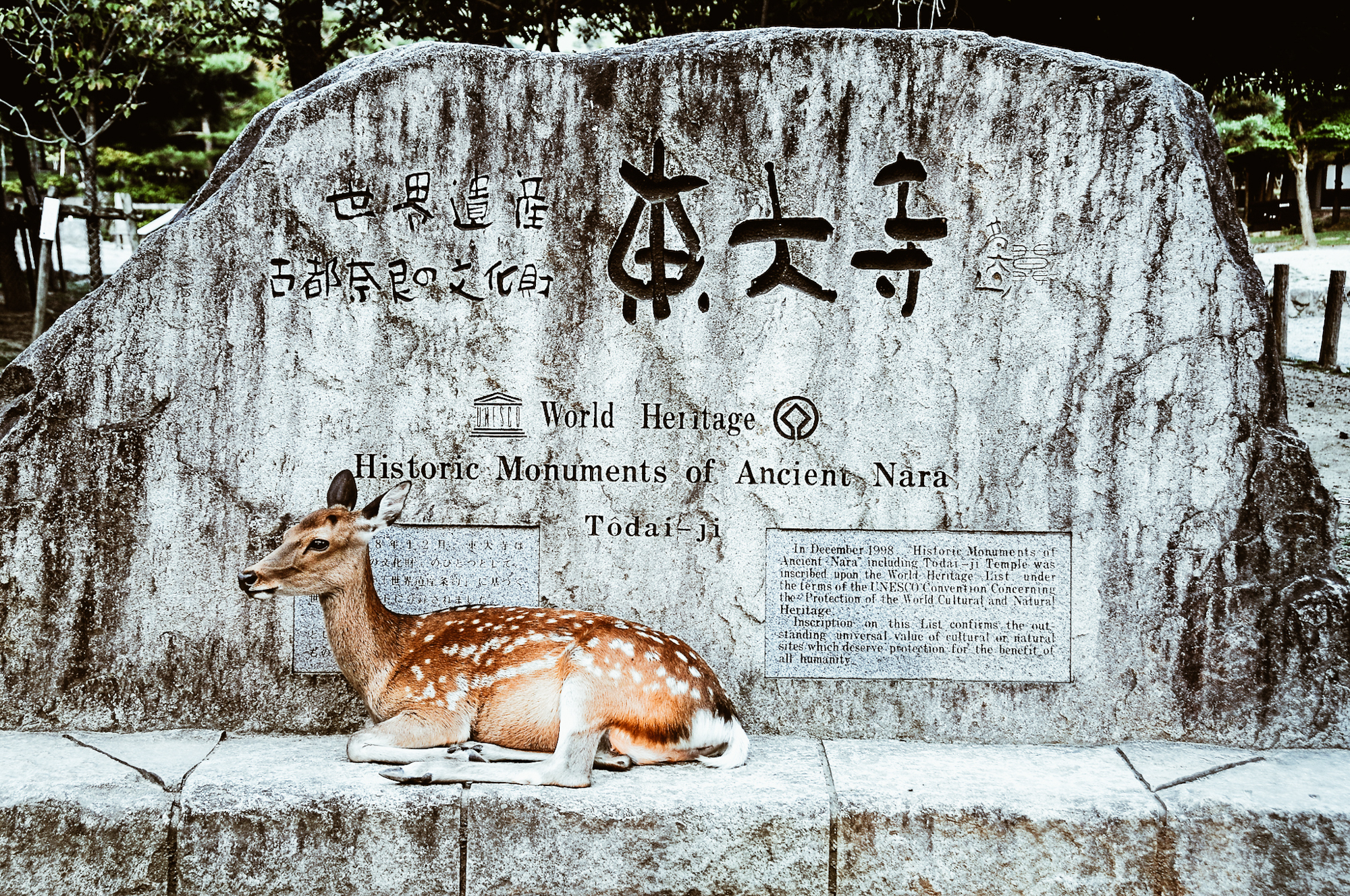

photo credits: lensonjapan, Blondinrikard Fröberg
With eight temples, ruins of past periods and the famous deers, Nara remains not only one of the most beautiful cities in Japan but also one of the most popular destinations for tourists. During the Nara period, the city was the capital of Japan and the emperor lived here before moving the headquarters to Kyoto.
The Heian period
During this period, a large source of theories was proposed for the origin of the name Nara.
Nara and The Nihon Shoki theory
The Chronicles of Japan, the second oldest book on classical Japanese history, says that the word Nara comes from narasu (to be flat, to level). According to this theory, in September of the tenth year of Emperor Sujin, some rebels climbed the Nara-yama. Here with the imperial forces, they joined together to lay down trees and plants and that is why the mountain is called Nara-yama. Being the most ancient testimony, it also has references in the folk culture. In fact, it is considerered the historical etymology by many scholars.

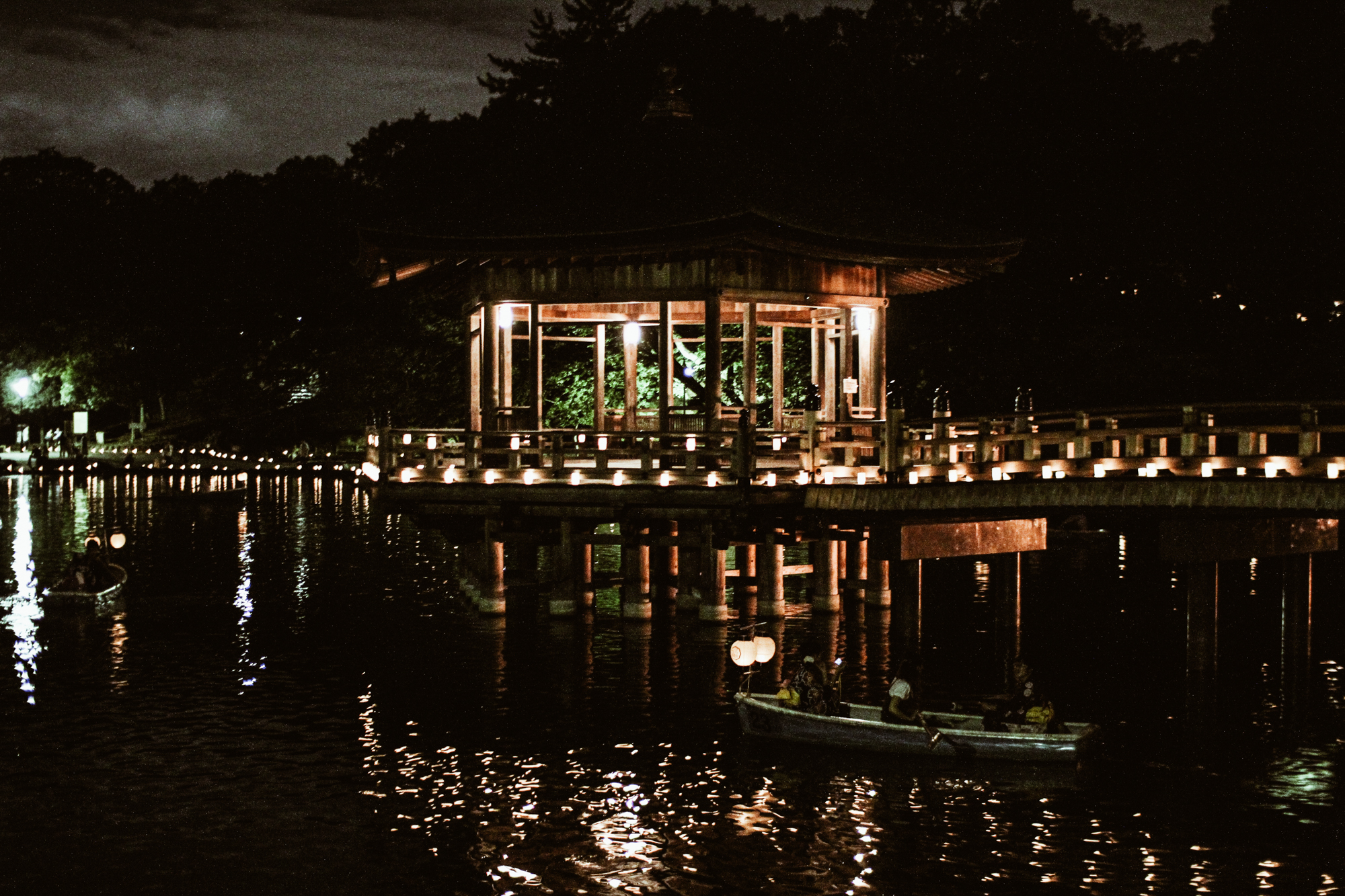
Nara and the "flat land" theory
Designed by Kunio Yanagita in 1936, this is the most accepted theory at the moment. In fact, this proposal attests that “the topographical conformity of a relatively flat area between a mountain called Taira in eastern Japan and hae in southern Kyushu, is called naru in the Chūgoku and Shikoku region of central Japan. This word gives origin to the verb narasu and to the adverb and adjective narushi”.
Moreover, this theory is also supported by some words inserted in reference to a flat area with the name of naru and naro in many dialects . To further support this proposal, we also find the adjective narui, which is not strictly in Japanese standards, but we find it in use in the central areas of the country. The meaning of this word corresponds in fact to "kind", "gentle slopes" or "easy".
To further support this theory, Yanagita brings the fact that many of these names were written with the kanji 平 ("flat"). Obviously the fact that historically Nara was written with ideograms 平 or 平城 goes in support this theory.
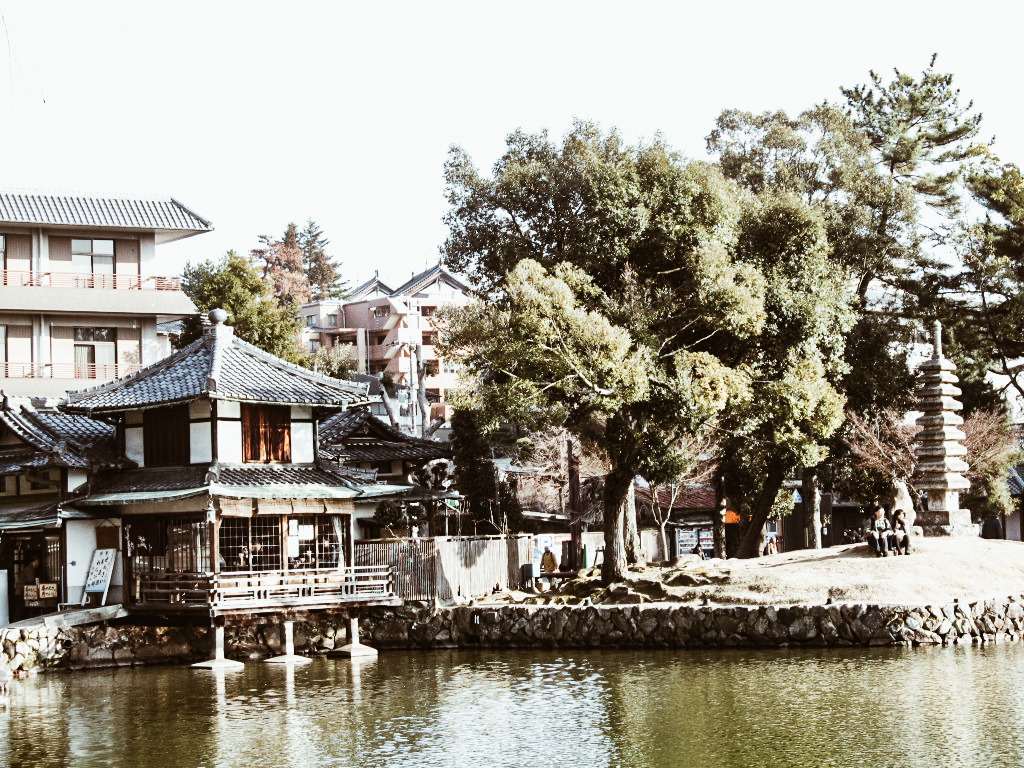
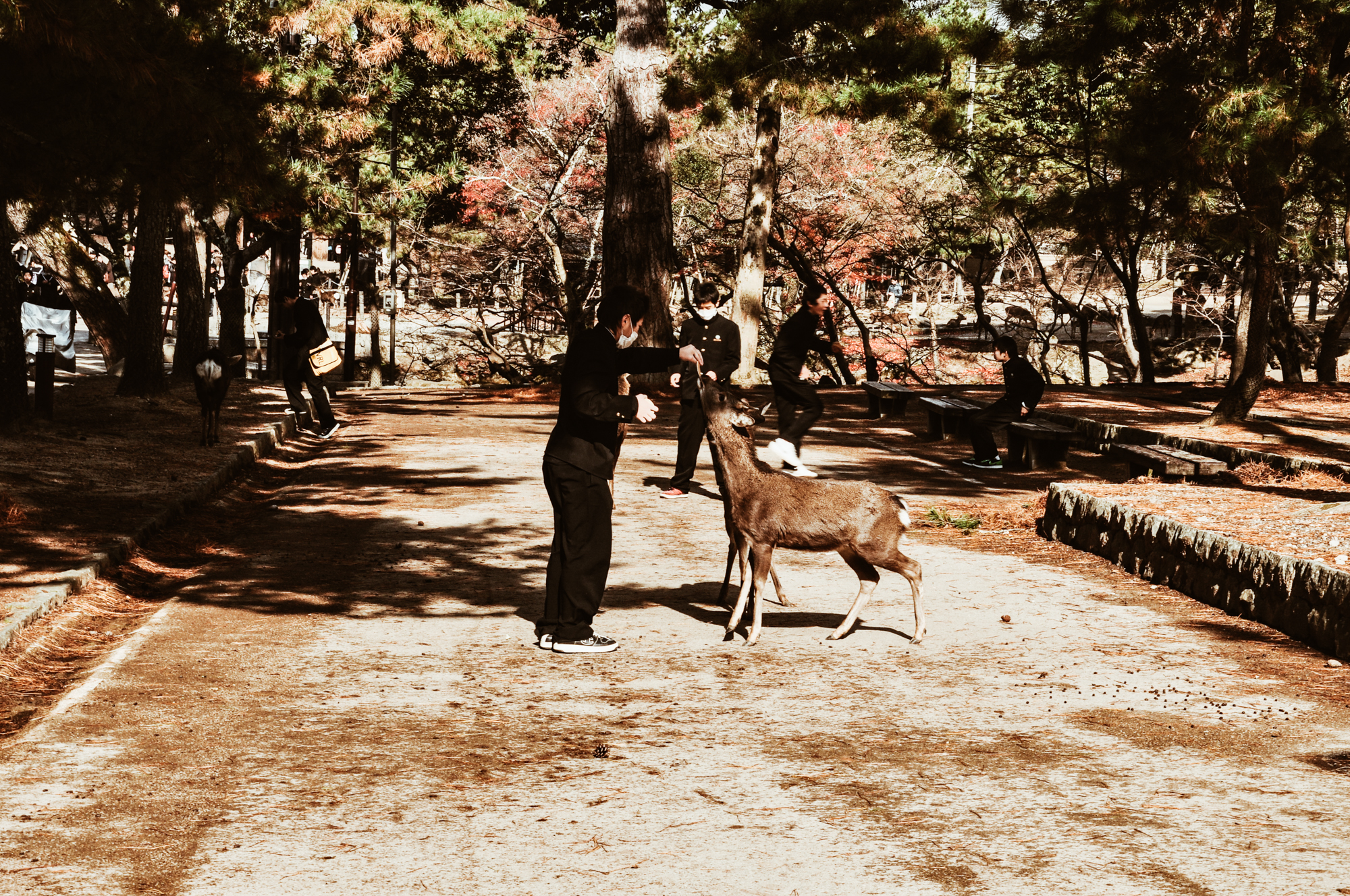
photo credits: chrizyshot, pantoniades
Nara and the oaks
Another common opinion is that Nara derives from the oak ideogram (楢). Suggested by Yoshita Togo, we can find this plant called by this name since the seventh and eighth centuries. In fact, Narahara at Harima (about today's Kasai) comes from the nara tree, which could support this theory.
The name Nara borrowed from Korea
This is an almost surprising curiosity. In Korean, indeed, nara (나라) means nation, kingdom. Matsuoka Shizuo claimed that this could be a valid source for the name of the city. However, there is little or no trace of ancient Korean, and there is no evidence that this word existed in the seventh century.
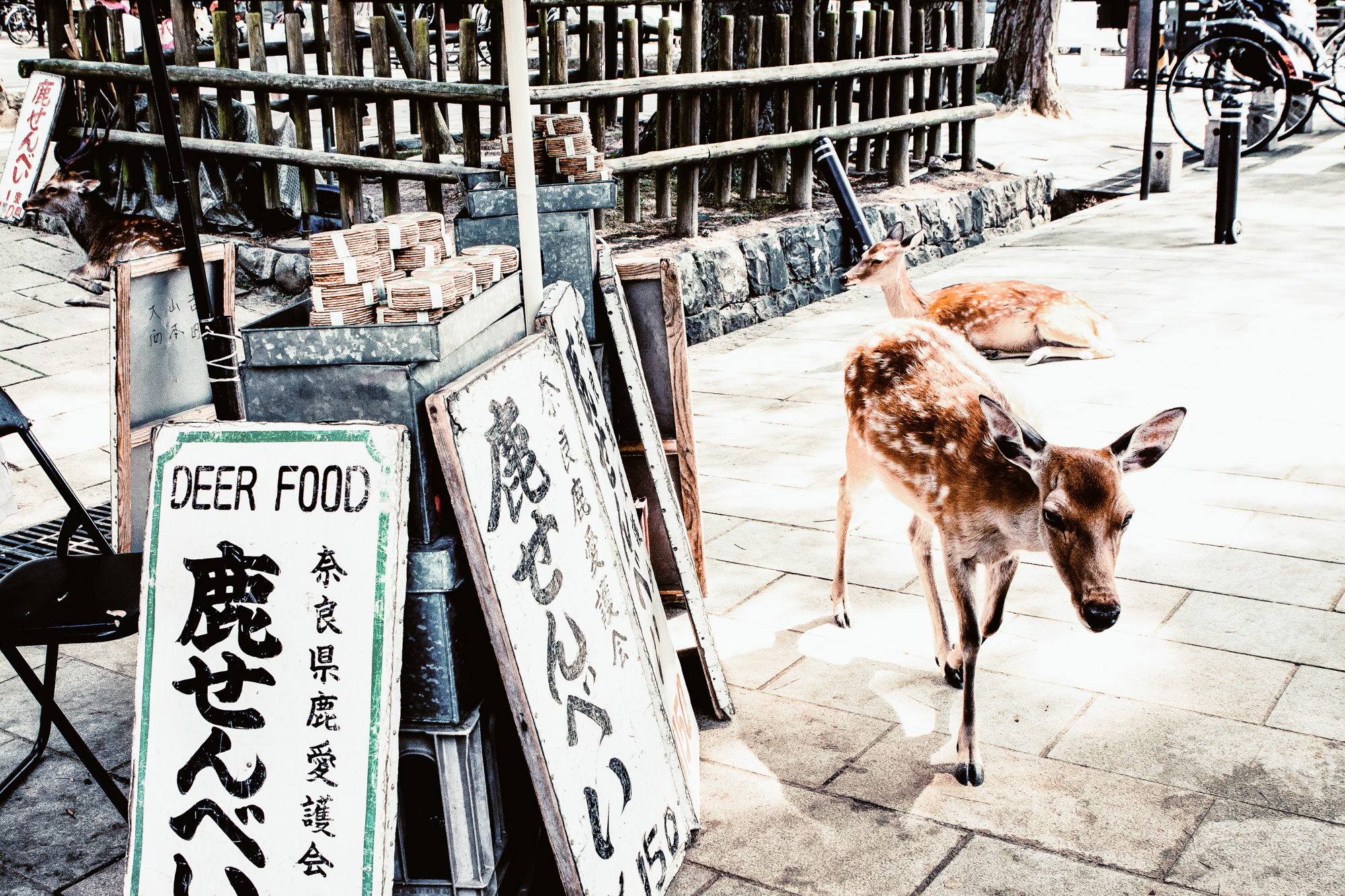

photo credits: Jirka Matousek, Rhett Sutphin
The origins
The Empress Genmei in 708 decided to move the imperial court to the new capital, Nara. Known as Heijō or Heijō-Kyō, the city was the first permanent capital of Japan until 794. Subsequently, the capital was moved to Nagaoka to force the metropolitan elites and new dynasties techniques that were spreading in the country. With the move to this city, we also have the birth of the eponymous period.
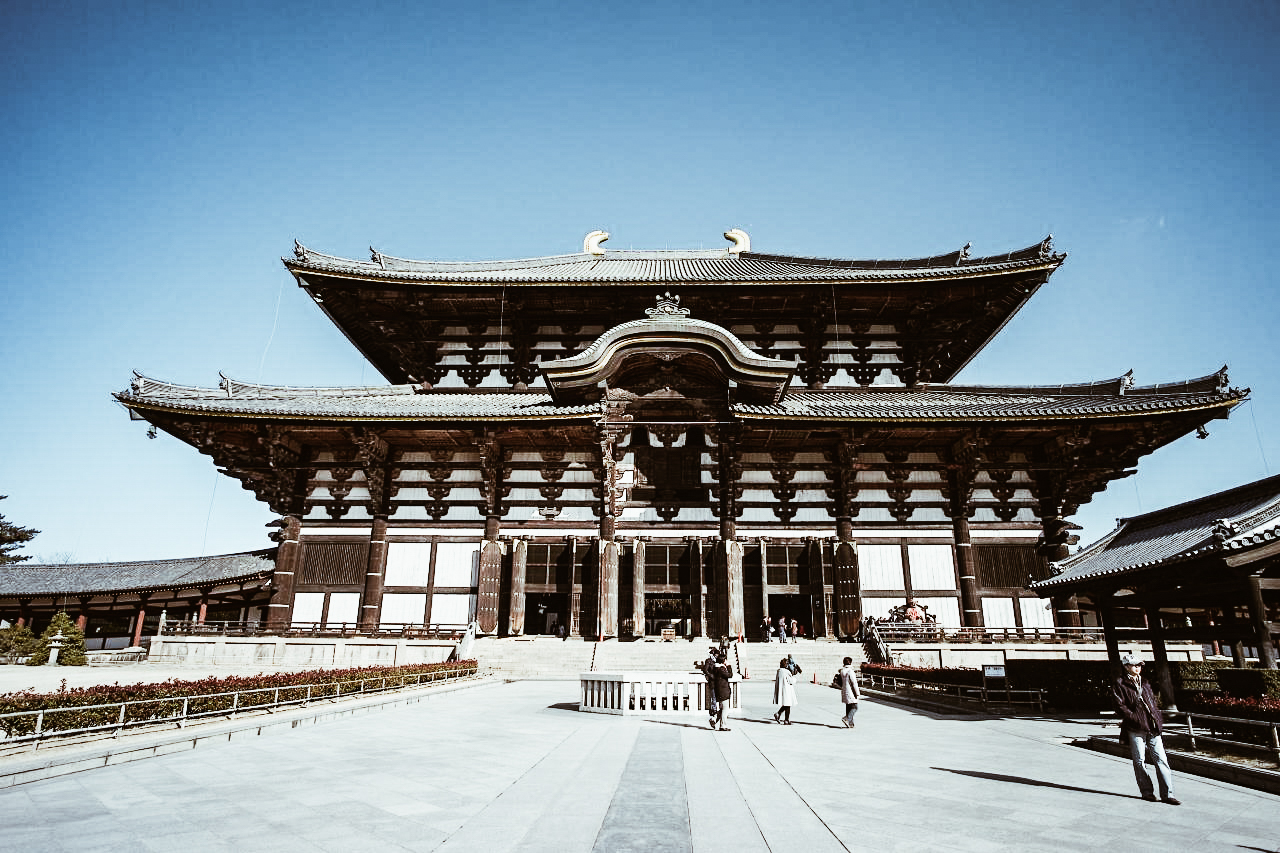
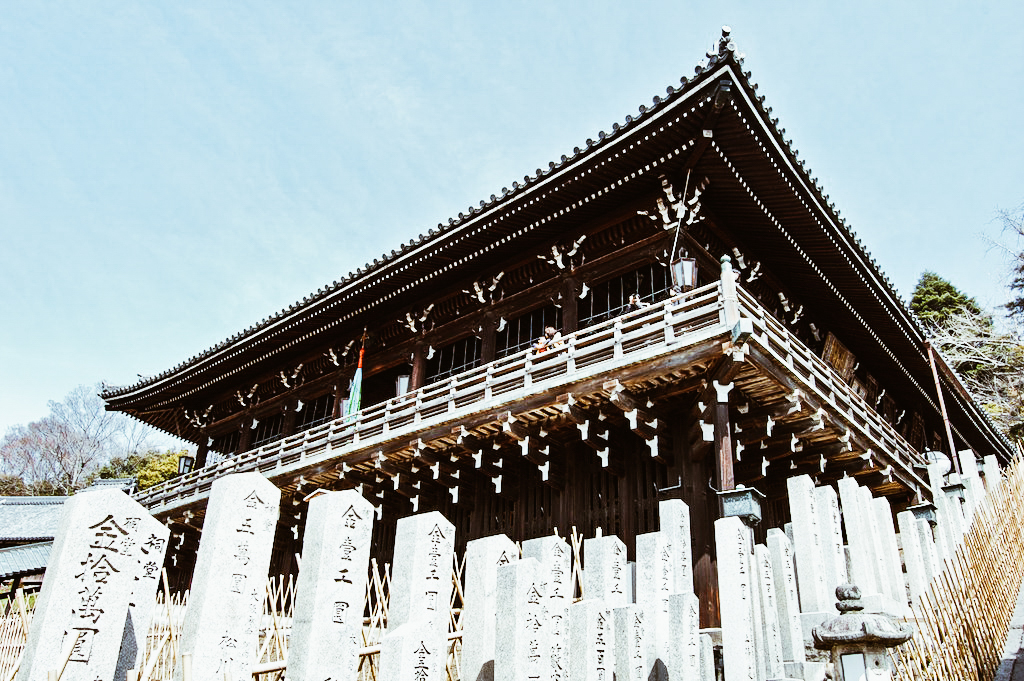
photo credits: Banalities, Josemspain
The religion
The six schools of Nara Buddhism, also better known as Rukushū (六宗), were an academic sect of Buddhists. Arriving in Japan from Korea and China in the sixth and seventh centuries, they were controlled by the new government of Nara.
Due to the government's involvement in religious expansion, we find the construction of several temples in the city. One of these is the site of the Seven Great Temples of southern Nara. However, these sects aimed to become the main school of Buddhism of the Imperial House of Japan and its nobility. Because of the conformation of these temples, the schools were precisely defined as the "Six schools of southern Buddhism in Nara".

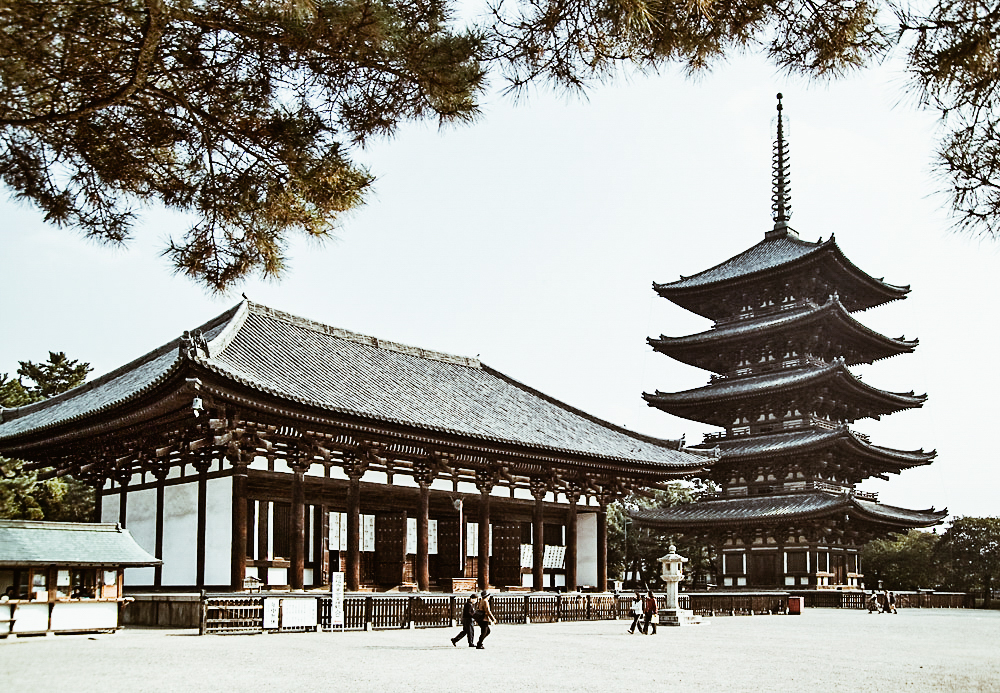
photo credits: wikipedia.it
The Temples
Having established Nara as a new capital, the temple of the Soga clan was also relocated. Emperor Shōmu ordered the construction of the Tōdai-ji temple and the largest bronze statue of Buddah.
The temples, known as the Nanto Shichi Daiji, remained spiritually important even after the capital was moved in 794. In fact, Nara received the synonym of Nanto (南都 "The capital of the south").

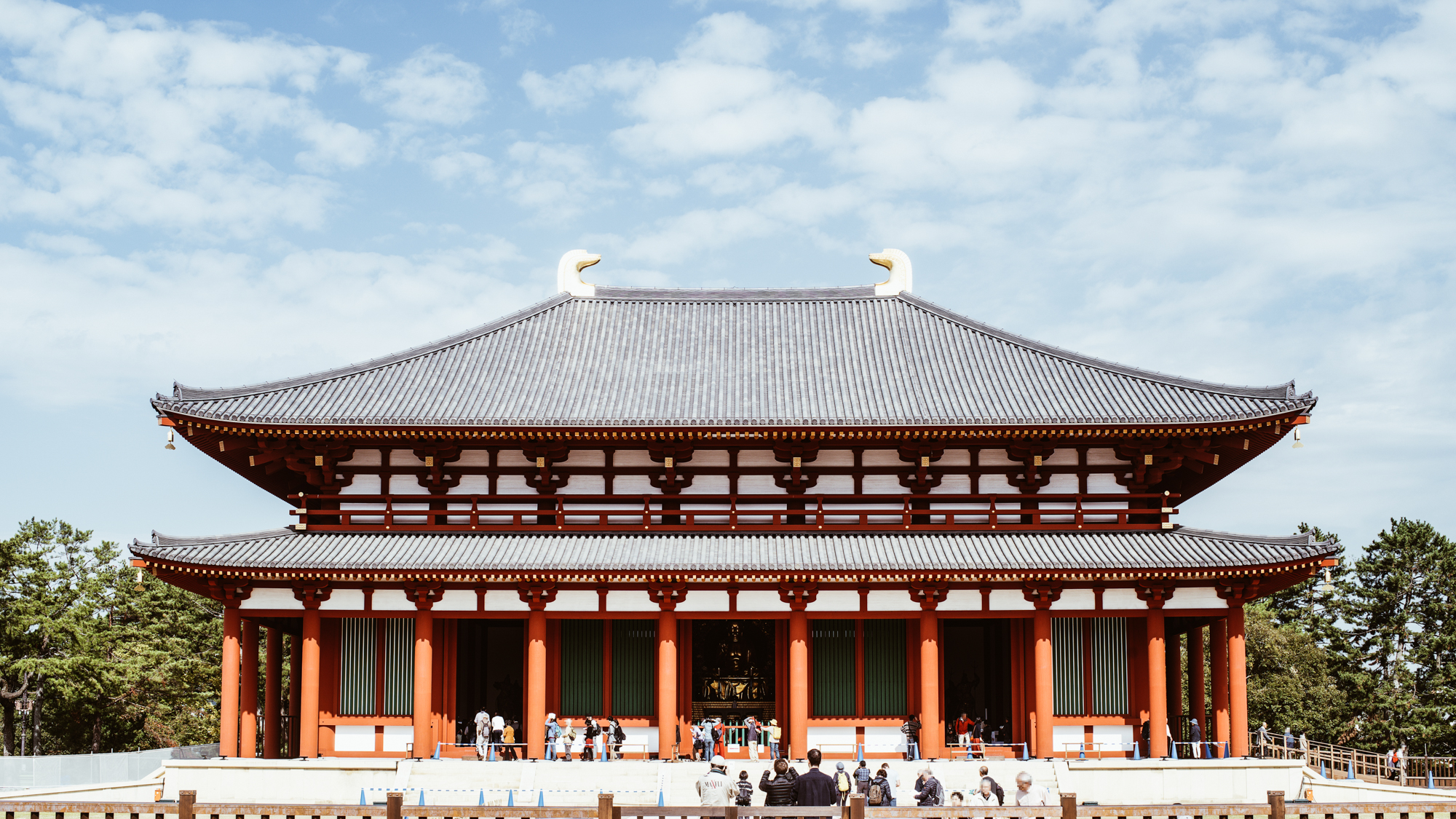
photo credits: wikipedia.it
Nanto Shichi Daiji
Literally "the seven great temples of the southern capital", a common historical name referring to the Buddhist temple complex located in this city.
- Daian-ji (大安寺)
- Gangō-ji (元興寺)
- Hōryū-ji (法隆寺)
- Kōfuku-ji (興福寺)
- Saidai-ji (西大寺)
- Tōdai-ji (東大寺)
- Yakushi-ji (薬師寺)
Nara became a tourist city already in the Edo period. In fact, these years saw the publication of several maps for visitors to the city.

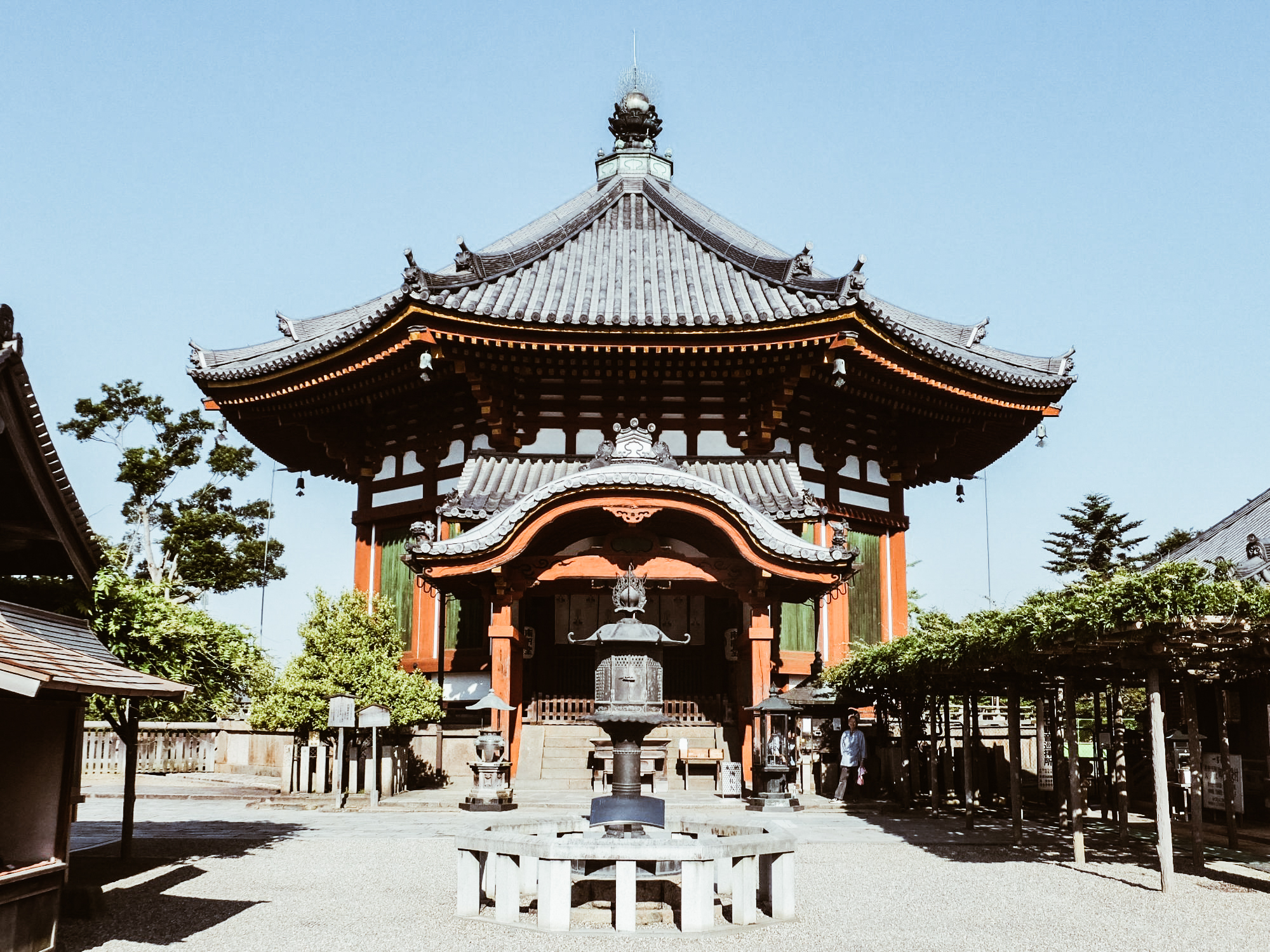
photo credits: wikipedia.it
The modern city
Despite being the capital of Japan from 710 to 794, Nara officially became a city only on February 1st, 1898. From a trading city of the Edo and Meiji period, today Nara is one of the main destinations for tourists thanks to its large number of monuments. Furthermore, in December 1998, the city became part of the protected sites recognized by UNESCO as a heritage of humanity.
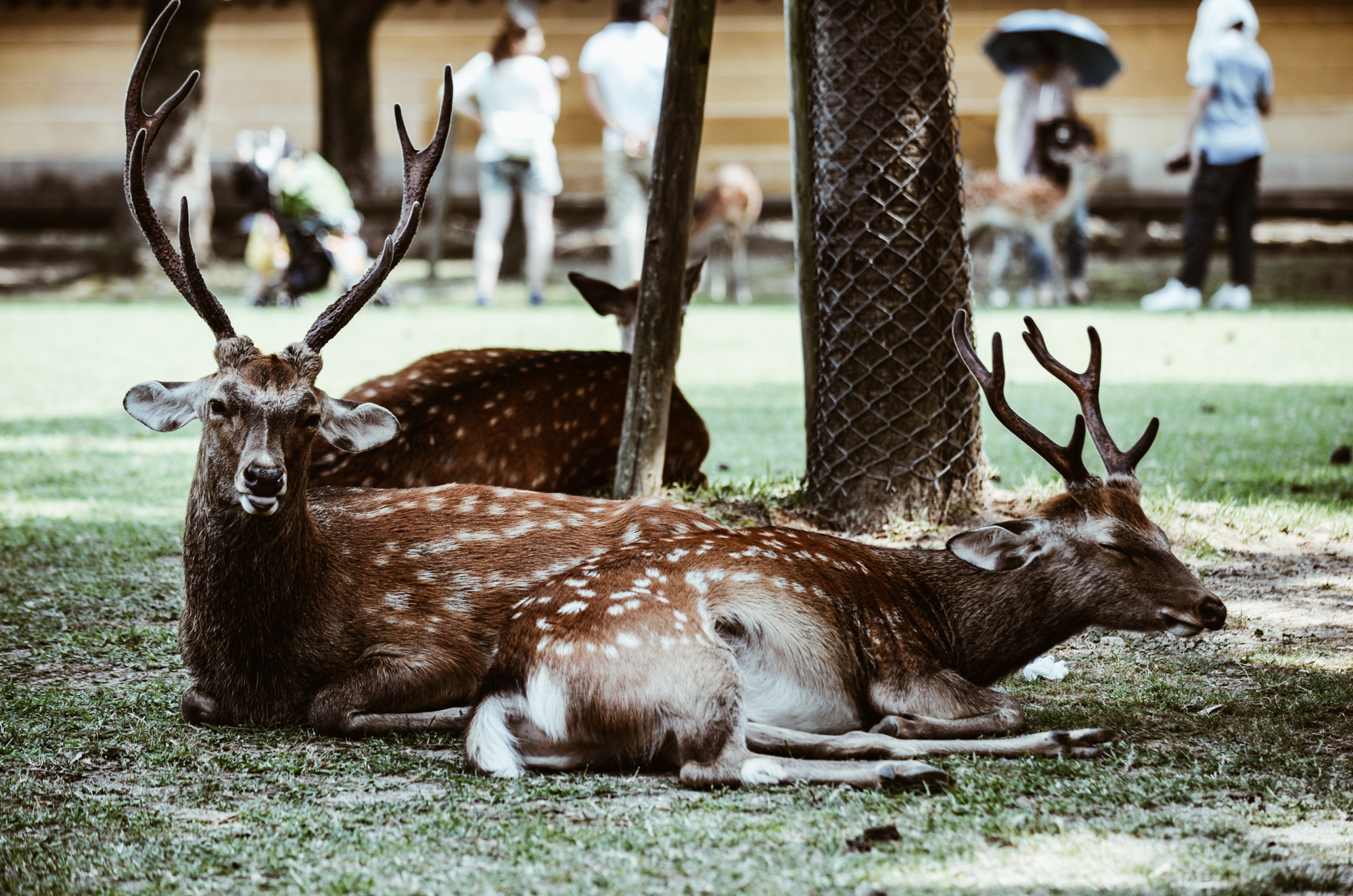
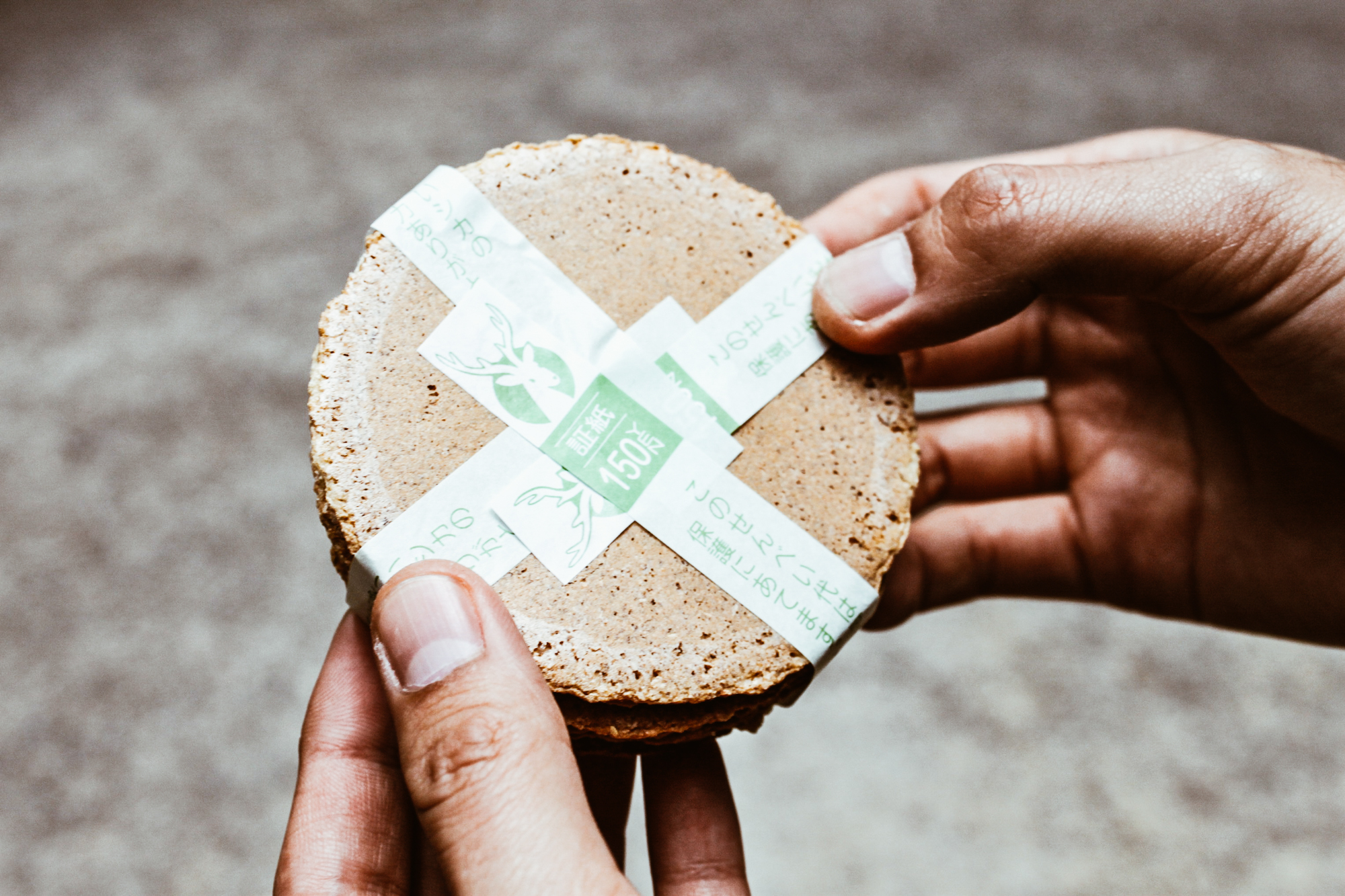
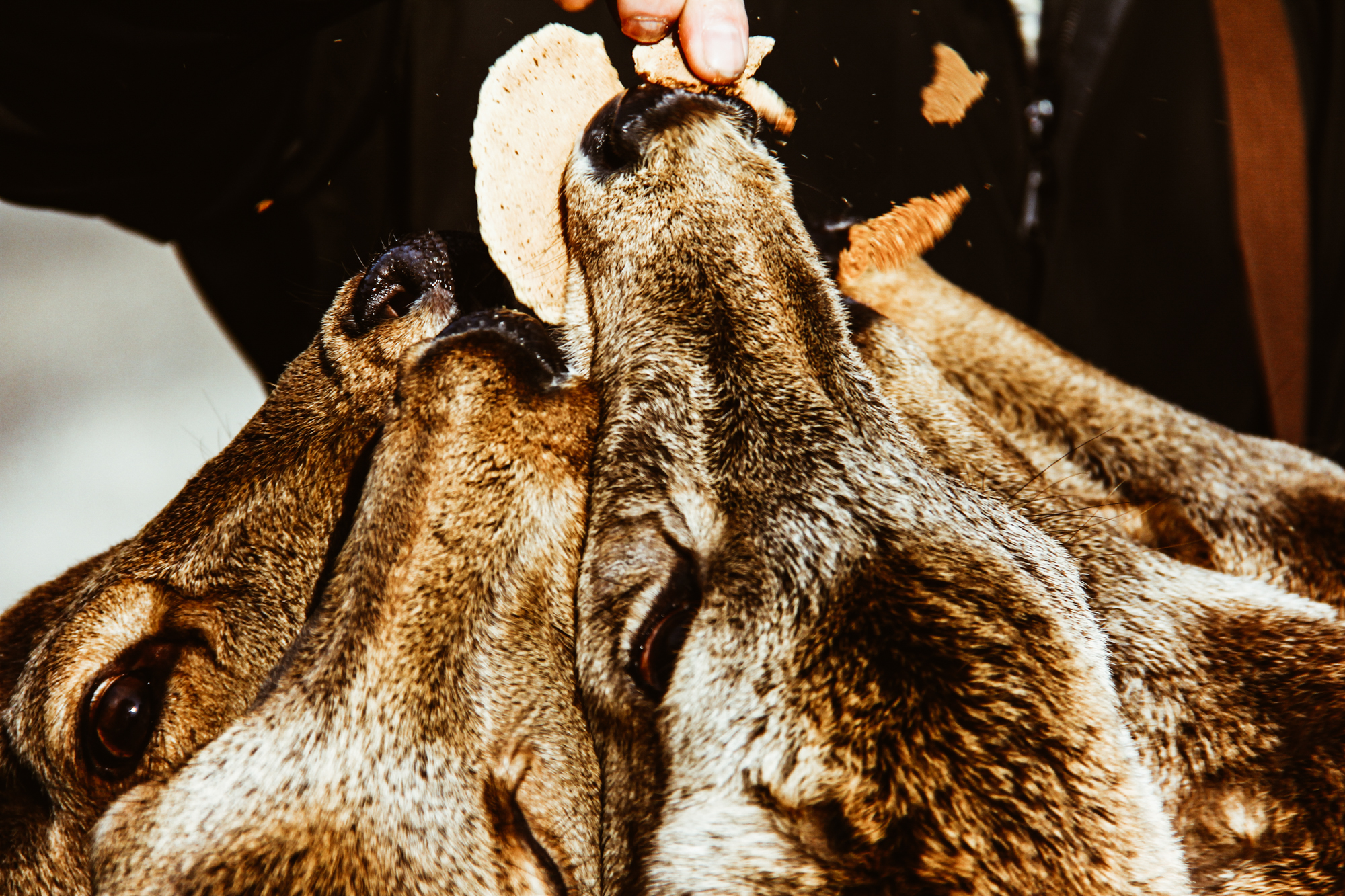
photo credits: GGzeOuf, Travis, Cesar I. Martins
The park and the deer
Surely, one of the most famous destinations is the park of Nara together with its famous deers. This is a public park established in 1880, located at the foot of Mount Wakakusa. Under the control of the Prefecture of Nara, this magical place is home to over 120 sika or shika, the famous Deers of Nara.
In fact, visitors can walk through the meadows accompanied by these cute four-legged friends classified as a "natural monument" by the Ministry of Education, culture, sport, science and technology.
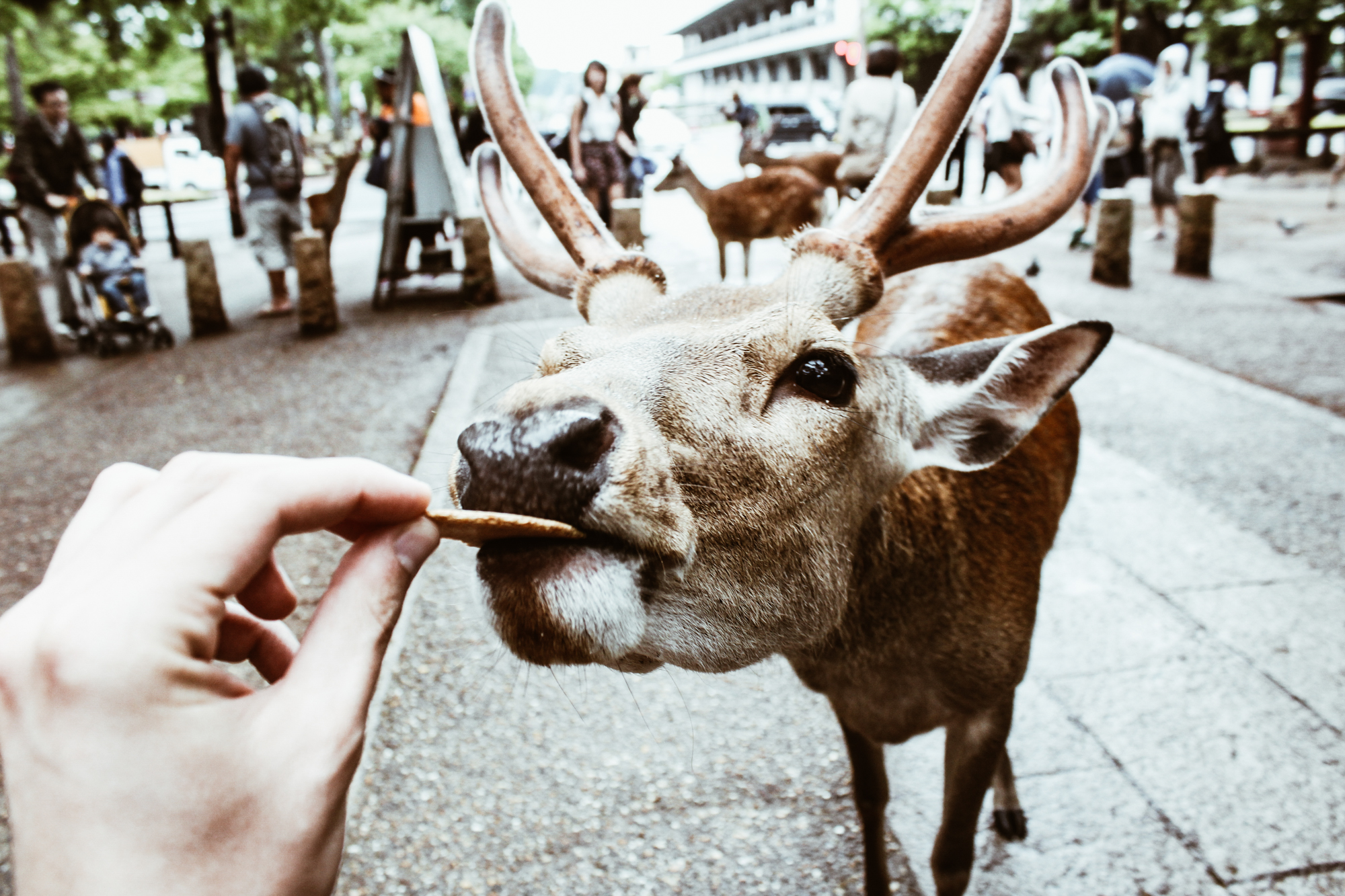
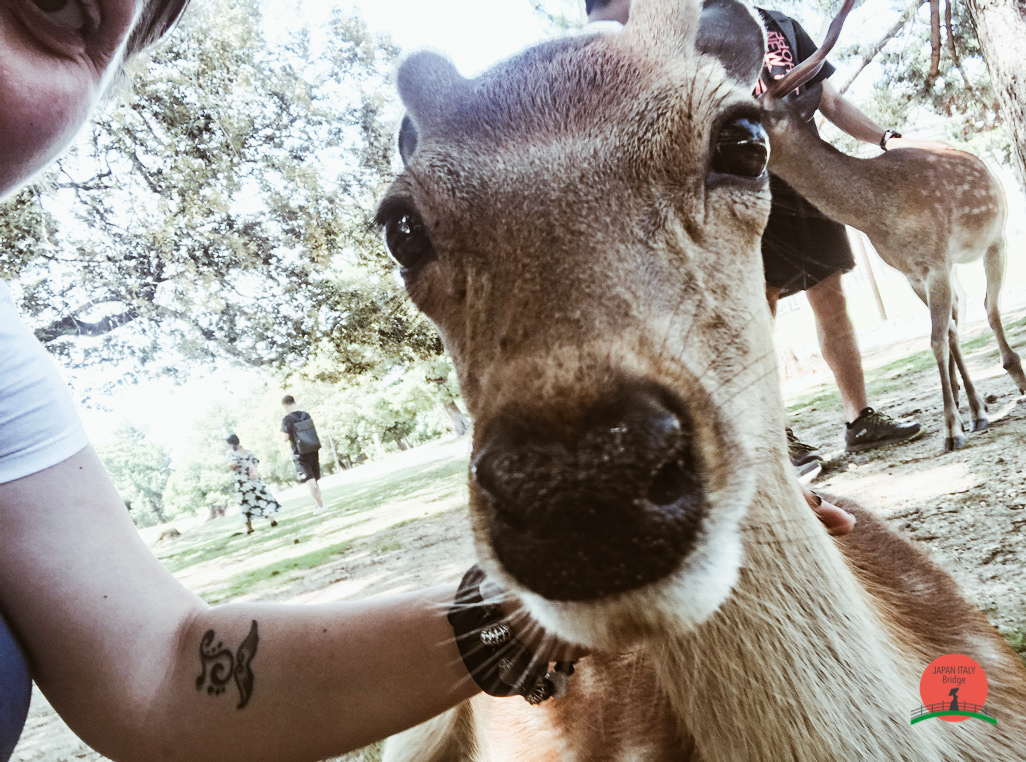

photo credits: Alberto Ortega, japanitalybridge.com
According to the locals, this area's deer was considered sacred and ideal for a visit from one of the four gods of the Kasuga shrine, Takenomikazuchi-no-mikoto. Appearing on Mount Mikasa-yama, it is said to have been sent by Kashima (Ibaraki) riding a white deer.
These deers are still considered sacred and divine symbols of the Kasuga and Kōfuku-ji shrine. The killing of one of these was considered a capital crime and punishable by death until 1637. After the Second World War, the deer was officially stripped of its state of divinity and named "national treasure", therefore subject to all the protections of the government.
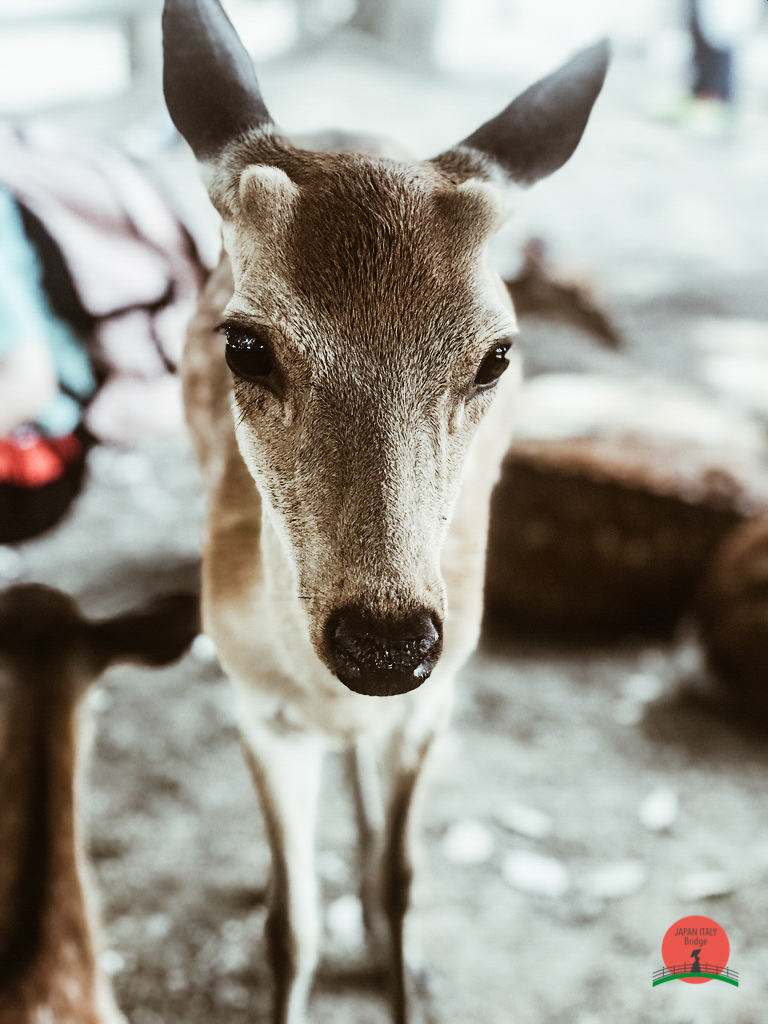
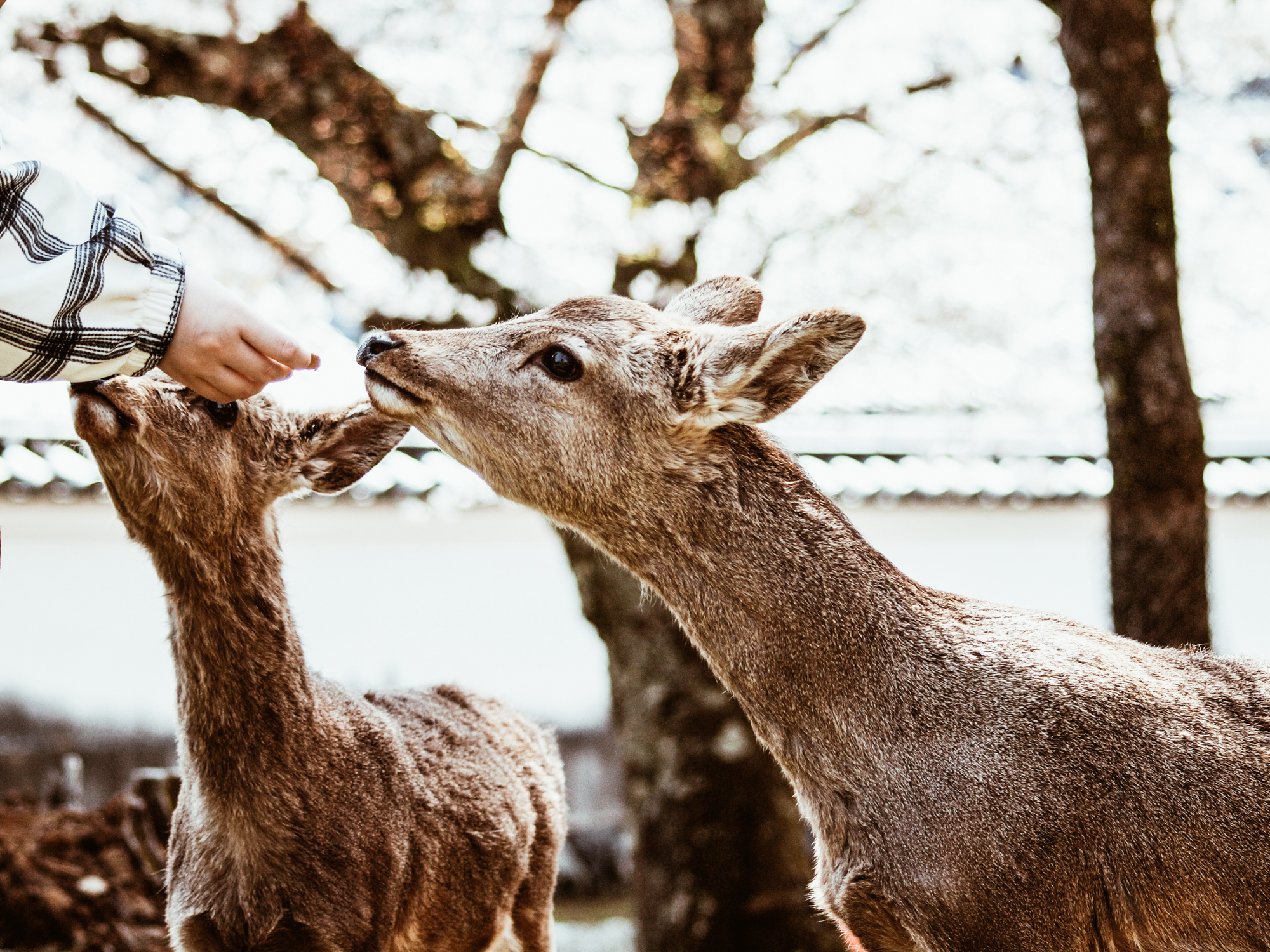
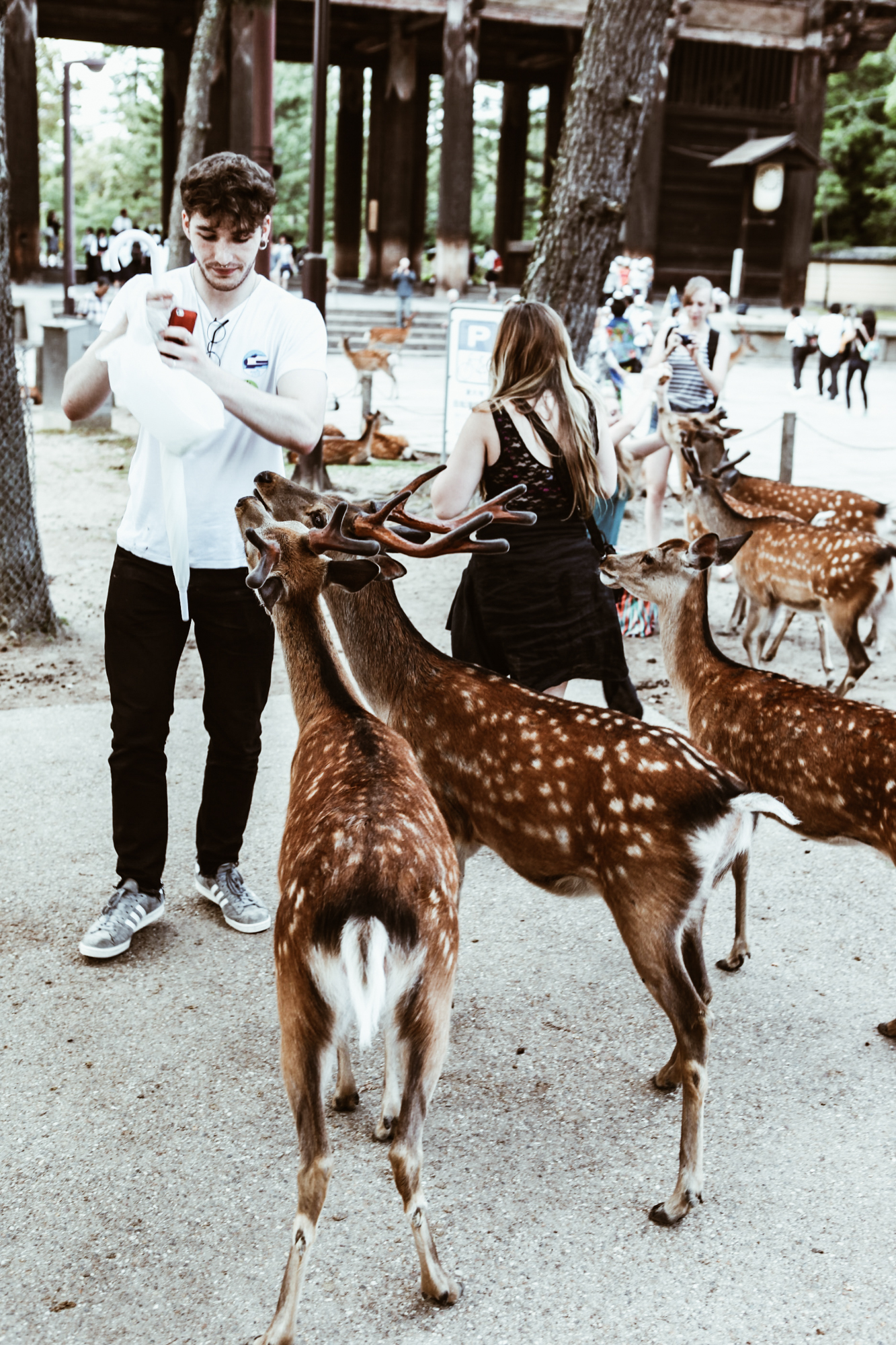

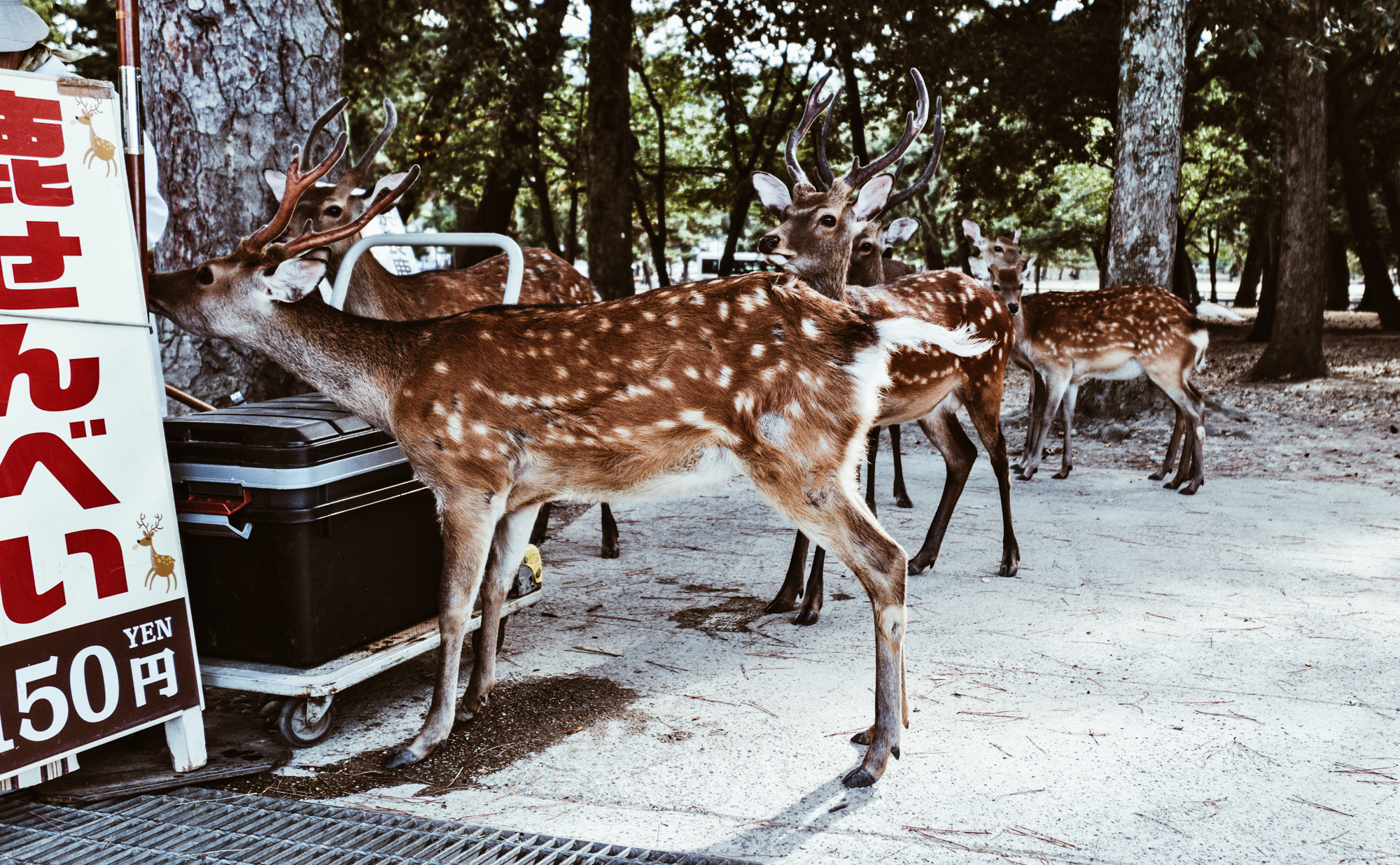
photo credits: japanitalybridge.com, coniferconifer, Bill Hails, Steffen Flor
If you pass through this city, you cannot miss the opportunity to spend time together with these magnificent creatures. It is also possible to buy special biscuits to feed the famous Nara deers. They will thank you with a bow, but be careful, the greed is around the corner, be careful not to get bitten!
video credits: japanitalybridge.com
TENOHA & | TASTE - Hakken menu returns
Holidays are over and with the reopening of TENOHA it is possible to taste the new menu starting today! Following the success of the first Hakken menu session, TENOHA accompanies you on another exciting journey through Japan's prefectures.
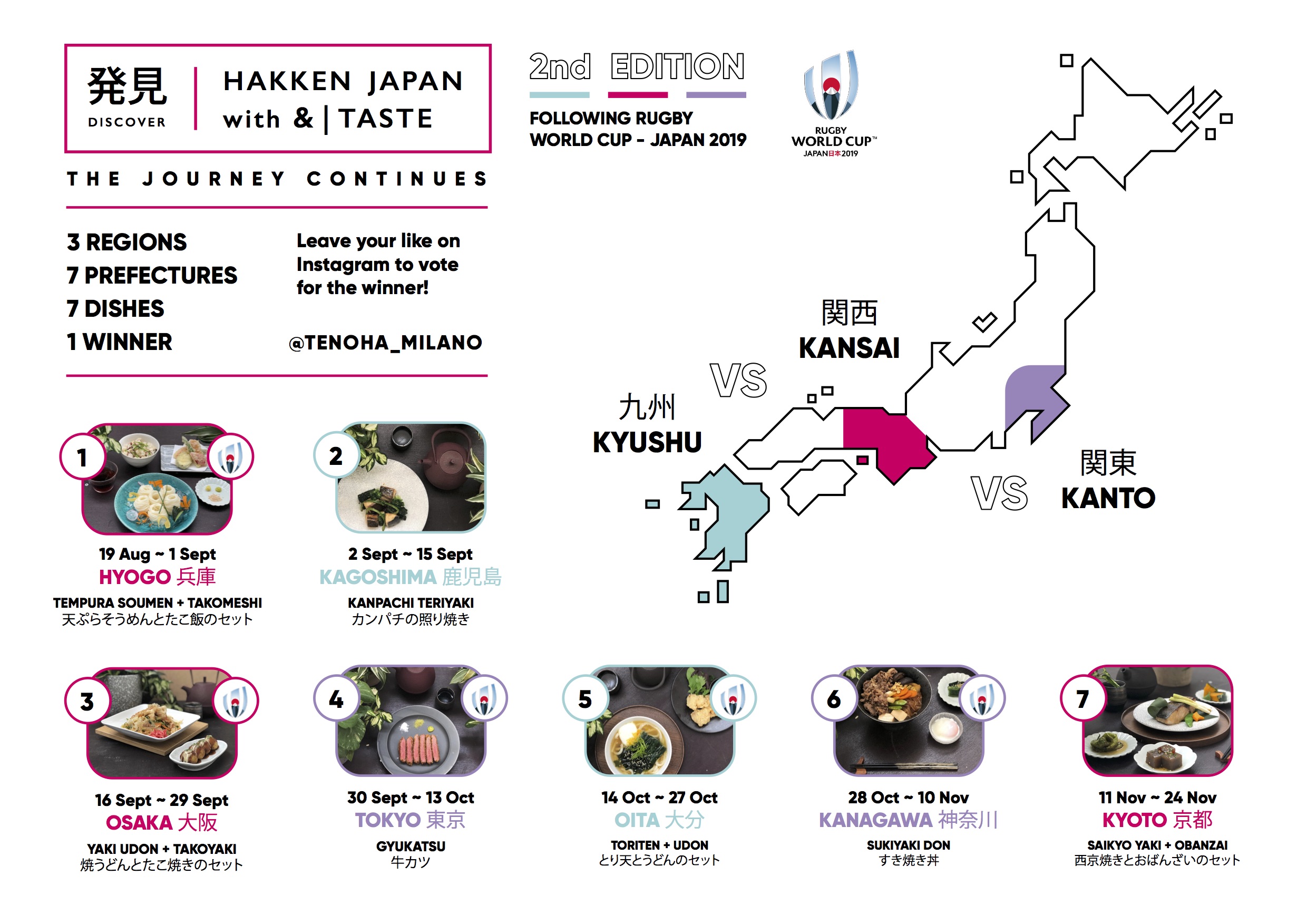
Hakken Menu
Soumen & Takomeshi with Tempura
19 August - 1 September: Soumen & Takomeshi with Tempura (そうめんとたこ飯のセット 天ぷら添え) - Hyogo Prefecture
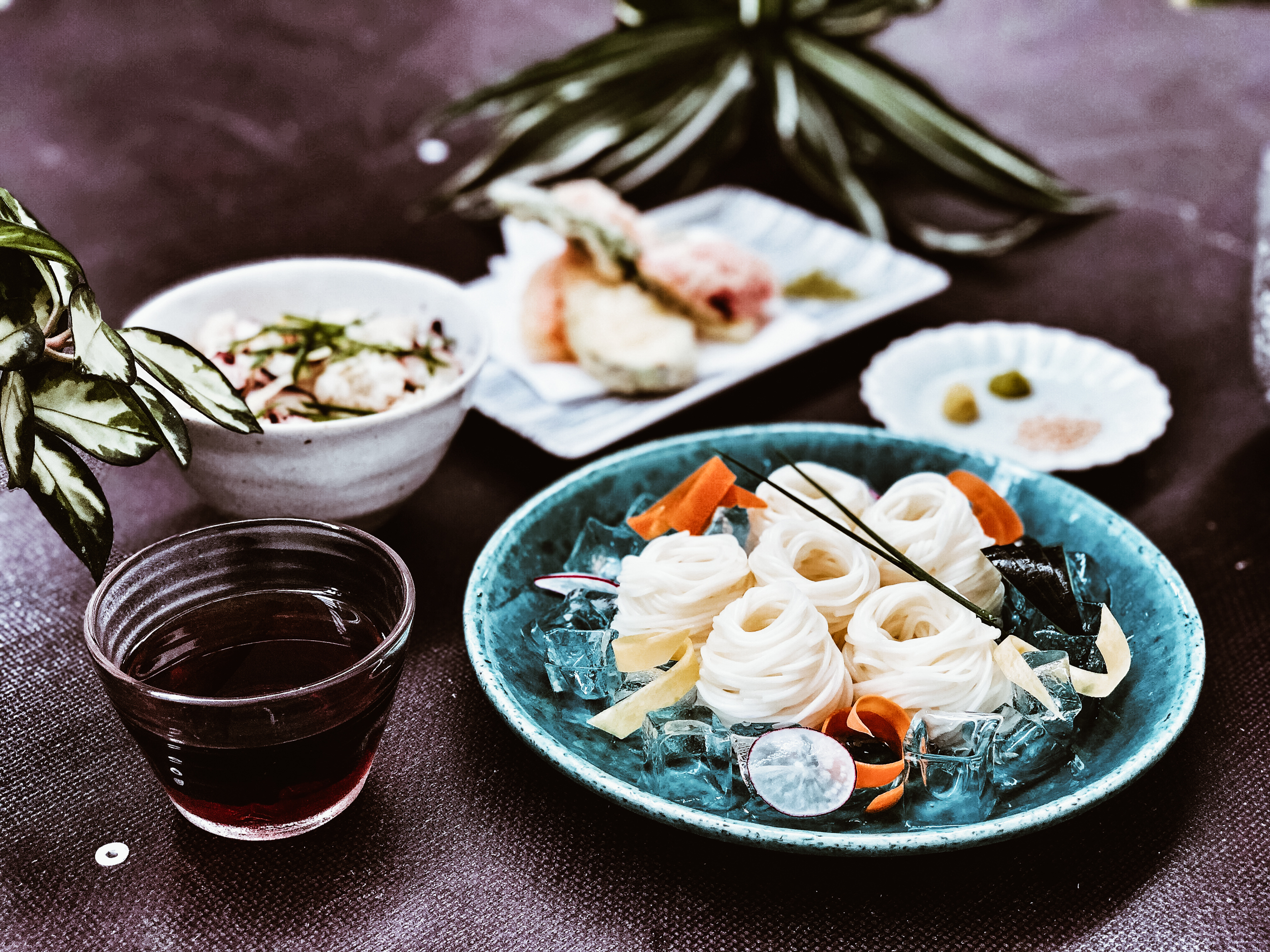
Hyogo Prefecture is located in the midwest of Japan and overlooks the Inland Sea of Seto and the Sea of Japan. The dish chosen for this prefecture is Soumen and Rice with octopus. For those of you who do not know what Soumen is, it is a thin Japanese white flour pasta and is popular as a summer dish. Rice with octopus is famous for being the local dish on the coast of the Seto Inland Sea.
These delicious Japanese noodles are served cold accompanied by dashi broth, rice bowl with boiled chicken and tempura of assorted vegetables.
Kanpachi Teriyaki
2 - 15 September: Kanpachi Teriyaki (カンパチの照り焼き) - Kagoshima Prefecture
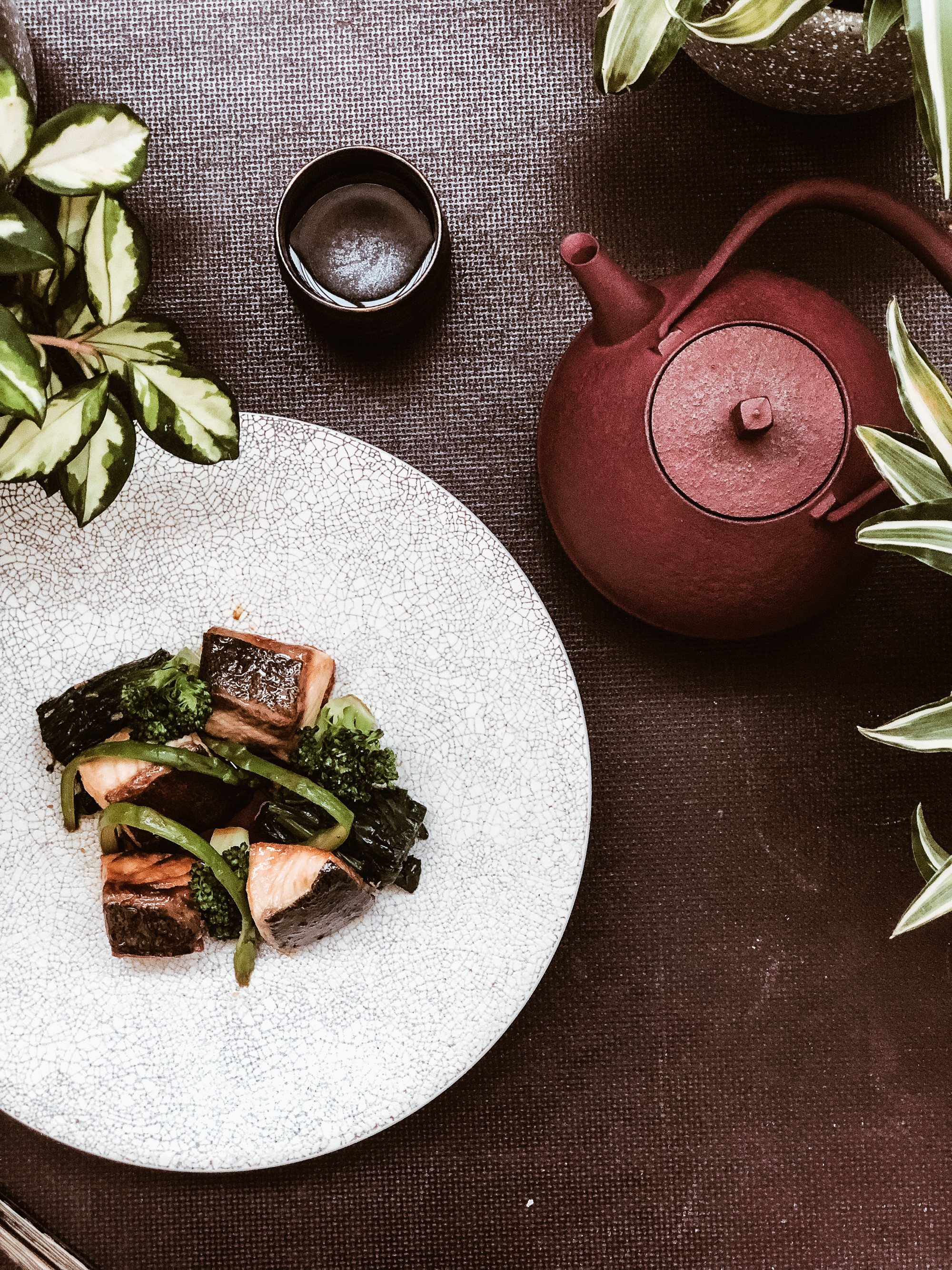
The prefecture of Kagoshima is located at the southwestern end of the island of Kyushu. With a similar scenario in Naples, the city of Kagoshima has long been called the "Naples of Japan" and twinning agreements have been signed between the city of Kagoshima and the city of Naples. The signature dish of this prefecture is the amberjack, the most cultivated fish in Japan. From September, you can get grilled amberjack in teriyaki sauce with seasonal vegetables, accompanied by rice and miso soup.
Ready to lick your chops? Stay tuned to discover the next dishes and we are waiting for you at TENOHA in via Vigevano 18, Milan!
Japan Tradition: Akita Kantō
The Akita Kantō (秋田竿燈まつり) is the Akita city festival. It is celebrated from 3 to 7 August with the aim of praying for a good harvest. This festival is very special, and to participate there is a need for special skills.
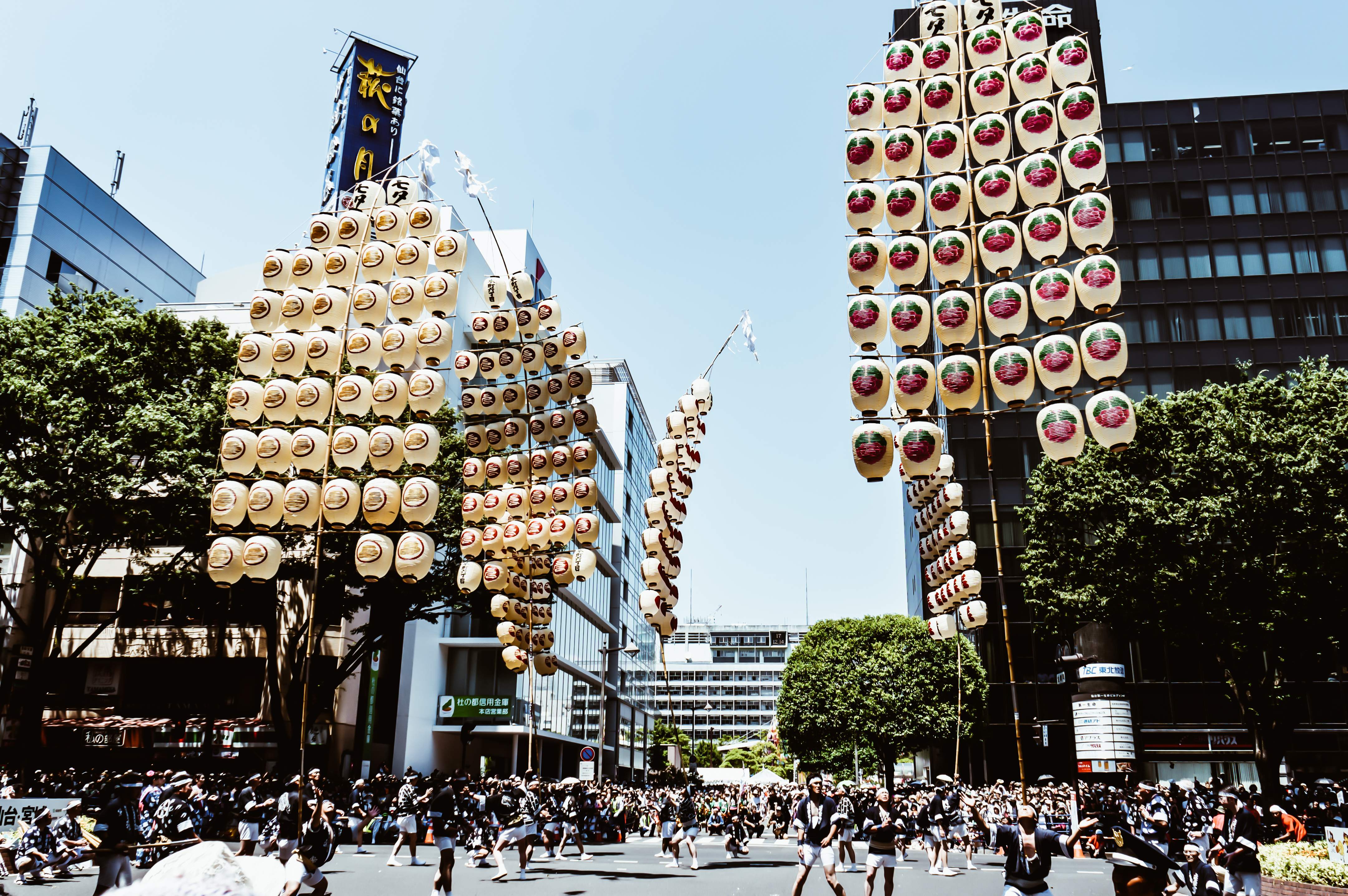
photo credits: Zamboni.
The peculiarity of the Akita Kantō
If you have never had the chance to attend this particular matsuri, surely today you will be surprised. In fact, the festivities consist of taking bamboo poles around the city by night. And so far it could even be simple, except that these poles have a length that varies from five to twelve meters. Furthermore, on top of these, there are twenty-four or twenty-six lanterns with gohei (wooden sticks) attached. The total weight of these poles can reach 50 kilos. They are transported through the city streets on the palms, foreheads, shoulders or backs of the participants.
The Akita Kantō is one of the main festivals in the Tōhoku region together with the Tanabata, the Aomori Nebuta Matsuri and the Hanagasa Matsuri. In fact, in 1980 it was defined as an important and intact property of folk culture.
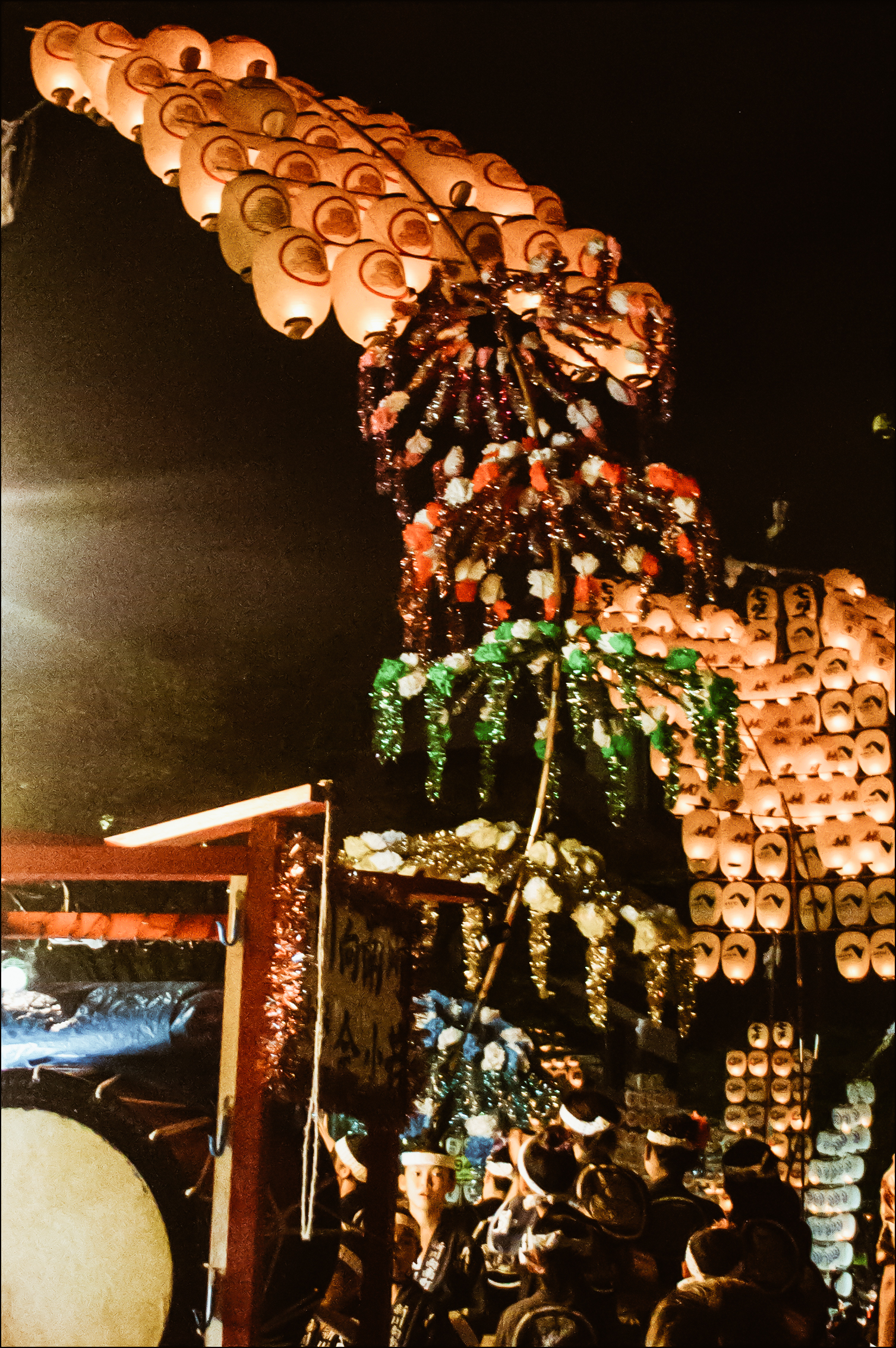

photo credits: Laura Tomàs Avellana, hitoyam
The origins
The festival originates from Neburi Nagashi, a celebration that was intended to free from illness and negativity during the summer. Already present during the Horeki period, in the middle of the Edo era, evidence can be found in various historical documents. One of these is "Yuki no huru michi" (written by Soan Tsumura in 1789). This is indeed the oldest documentation describing Neburi Nagashi, which says that the festival was held on 6 July according to the lunar calendar and it's defined as the original Akita tradition.
During Neburi Nagashi, people decorated bamboo trees and plants with pieces of paper where they wrote their wishes. Later, the participants walked around the city with these plants along with candles and lanterns. Later, Neburi Nagashi took the name of Kanto.



photo credits: foxeight
The history of the Akita Kantō
The current name of the event was used for the first time by Tetsusaku Okubo in 1881. In this period, in fact, the emperor Meiji visited Akita. Here Okubo suggested entertaining the emperor with the Kanto performance.
Due to the change of the lunar-to-solar calendar in 1872 and given the smaller number of Kanto participating in the festival, the realization of the latter began to be uncertain.
However, in 1908 the emperor Taisho visited Akita and fell in love with the Kanto performance. The following year, a soft drink company printed its products' names on the Kanto lanterns. These two events led to the restoration of the Kanto festival and its change of dates, to avoid the rainy season.
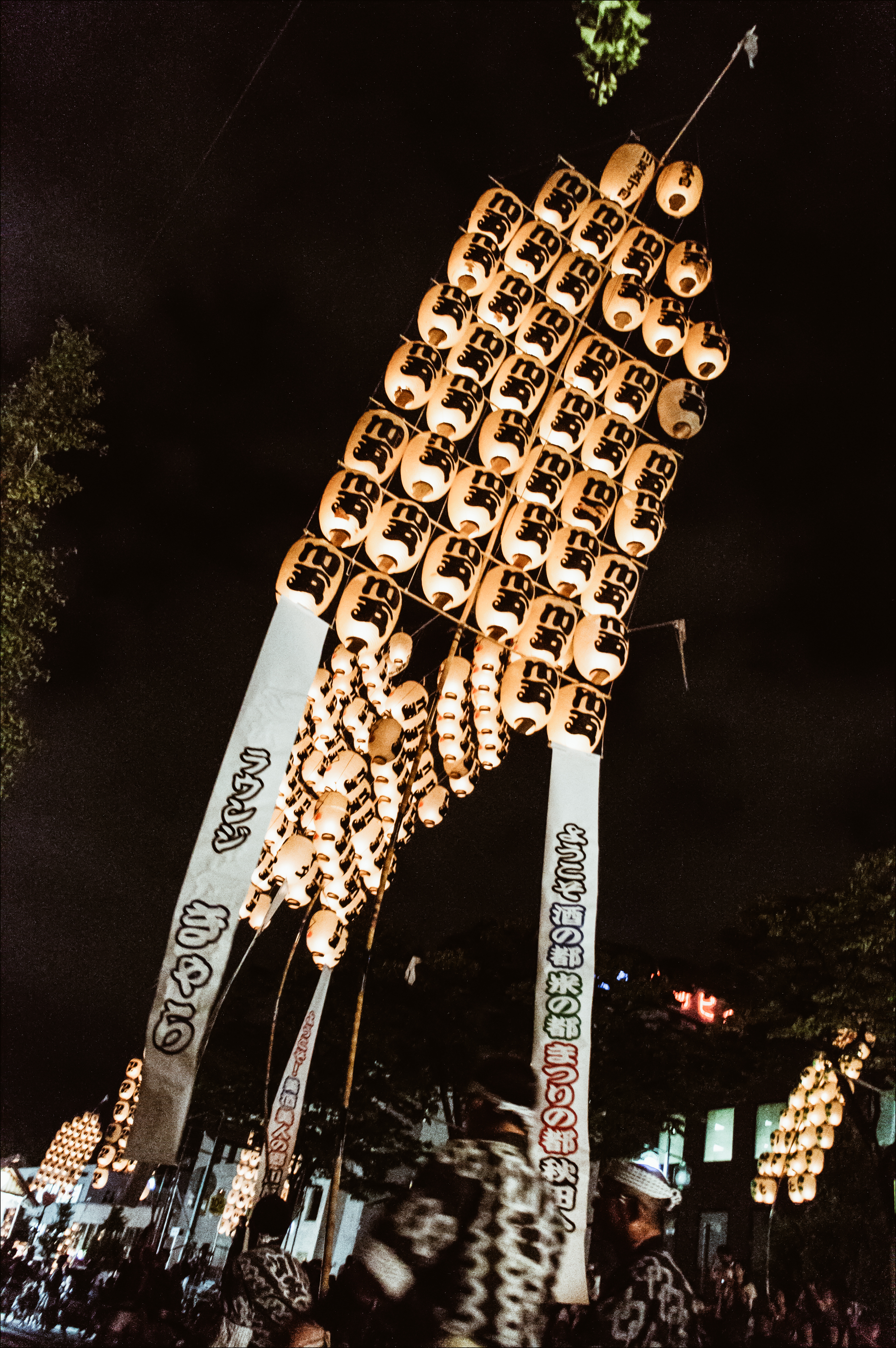
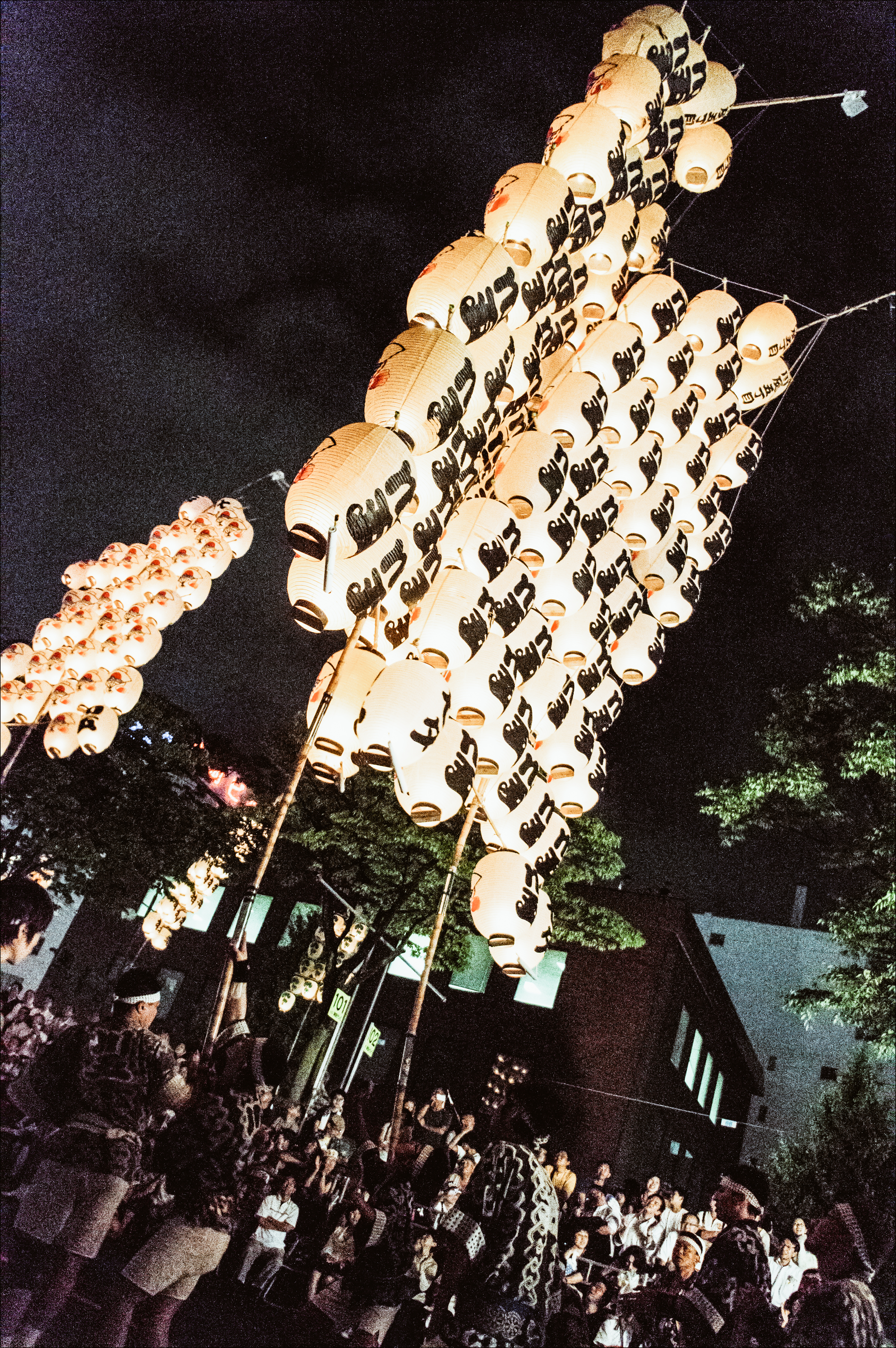
photo credits: Laura Tomàs Avellana
As a result, the number of visitors increased and the Kanto Society was established in 1931 was in charge of managing the festival.
Afterwards, the festival was canceled during the Second World War, and then after the end of the conflict, the Executive Committee of the Kanto Festival was created.
In 1976, after a successful performance in San Diego, USA, Kanto became popular in various countries.
Cos’è il Kantō
Literally, Kantō means "a pole with lanterns" and is made from bamboo poles and rice paper lanterns hung on horizontal bars.
The main bamboo pole is called "Oyatake" and they are of rather thick features and all produced in Japan. There are even very strict rules on the thickness and the spaces of junction from the root for these poles.
Therefore, people who choose the pole must be very demanding on the type of bamboo used to produce Kantō.

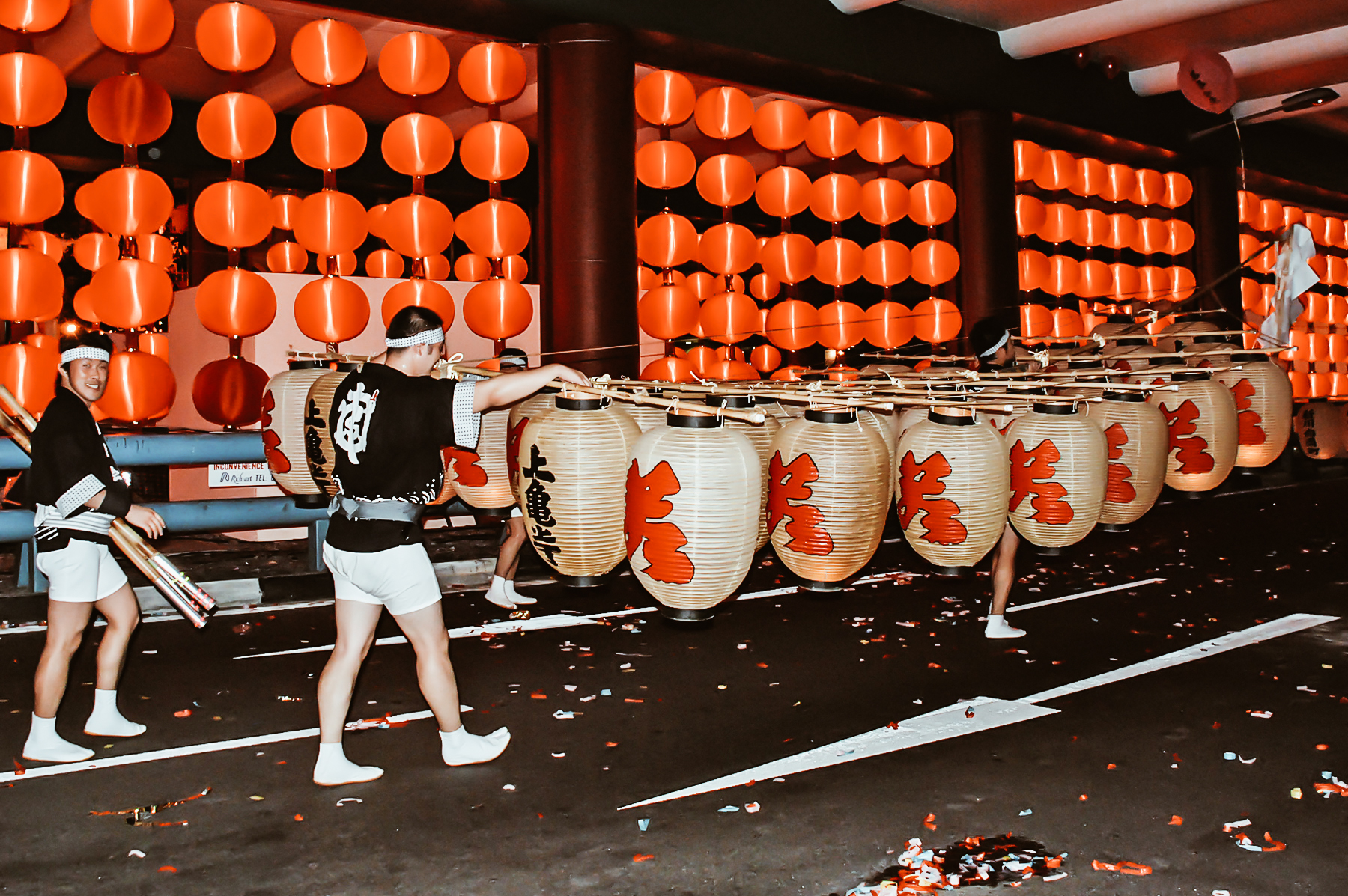
photo credits: Laura Tomàs Avellana, Choo Yut Shing
The horizontal branches are called "Yokotake" and it is here that lanterns are hung. The pieces of bamboo used to make the Oyatake even longer are called "Tsugidake".
The Kantō are divided into four categories with regulated length: Oowaka, Chuwaka, Kowaka and Youkawa.
Kantō techniques
There are various techniques for using Kantō from the name "Myogi" and divided into 5 categories.
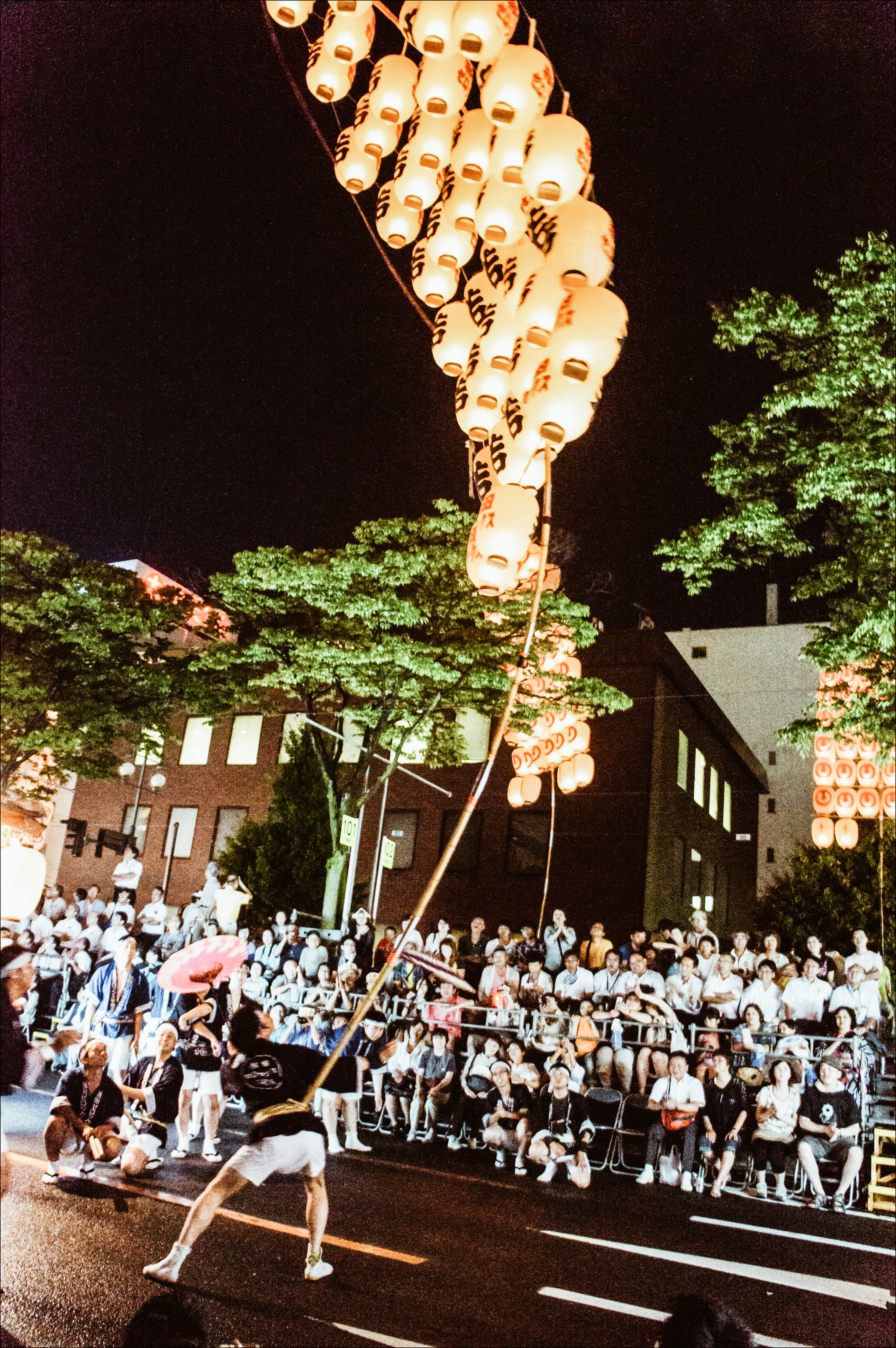

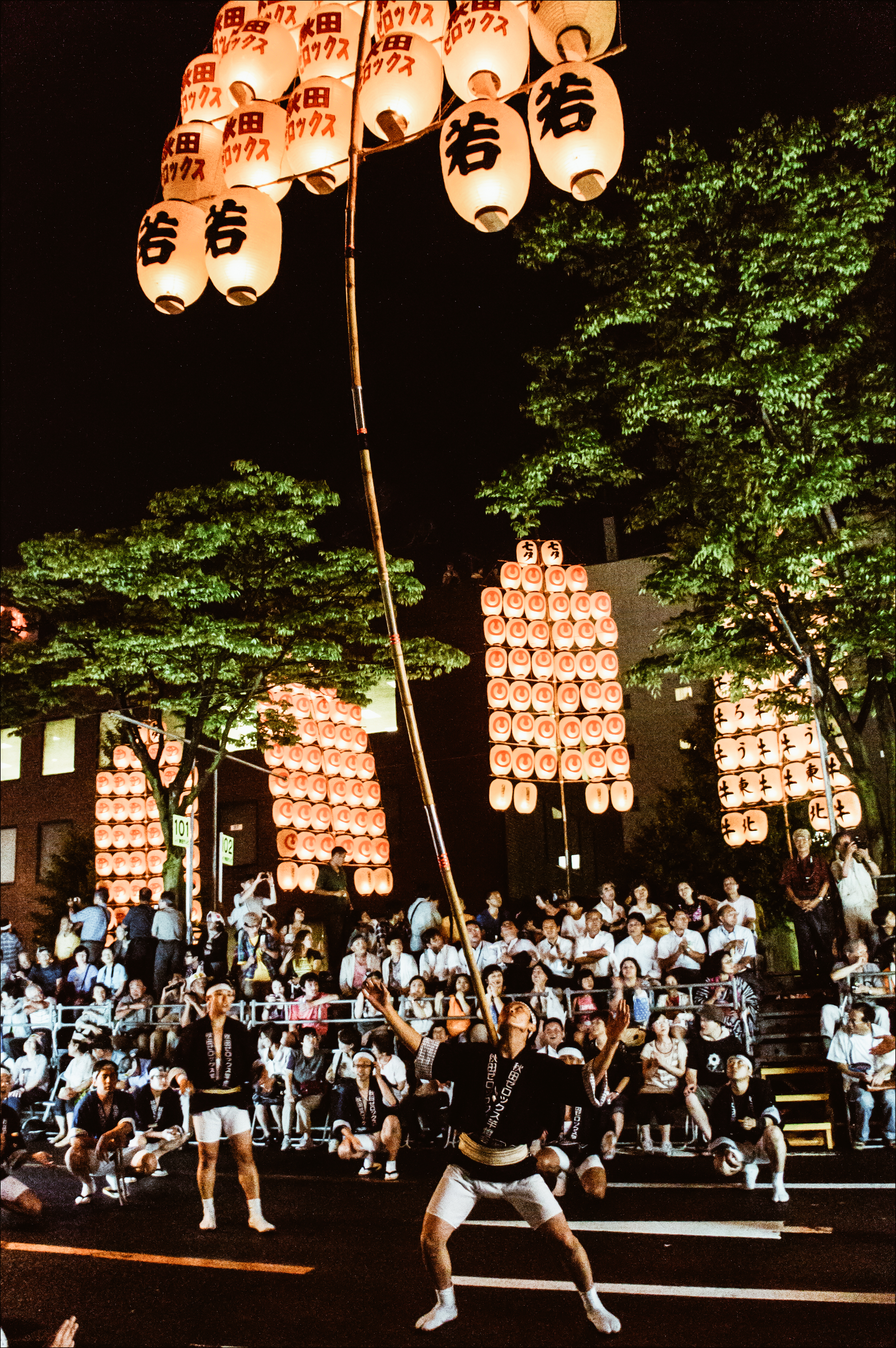
photo credits: Laura Tomàs Avellana
Nagashi
The artists hold the Kantō in the palm of their hands and balance it with their fingers. In this way, other artists can add Tsugitake
Hirate (hand)
The artists hold the Kantō still higher in the palm of his hand
Koshi (hips)
Kantō is held by the fingers. Later moved to the palm of the hand and then to the side. The artist bends sideways and balances with his own legs.
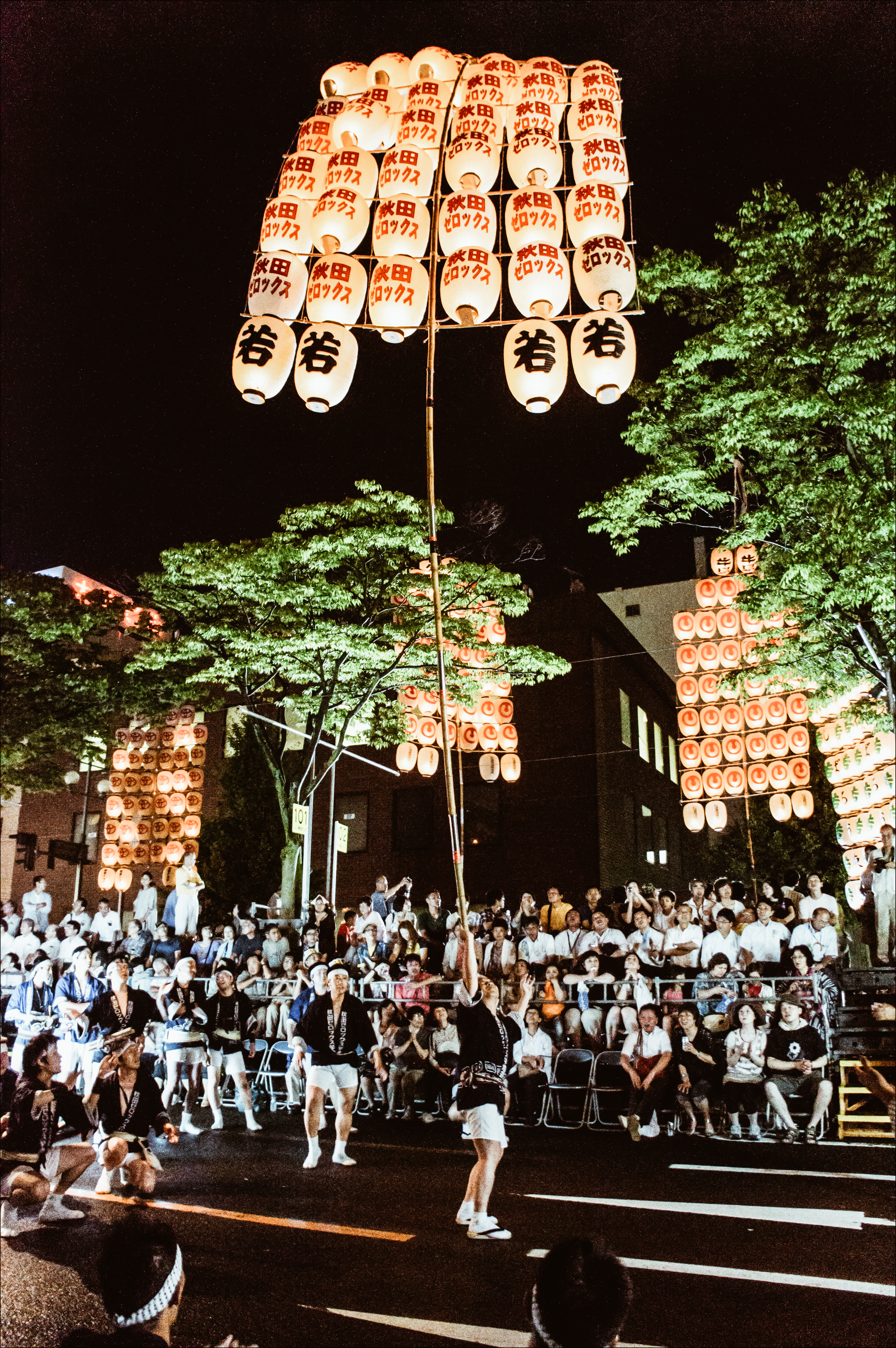
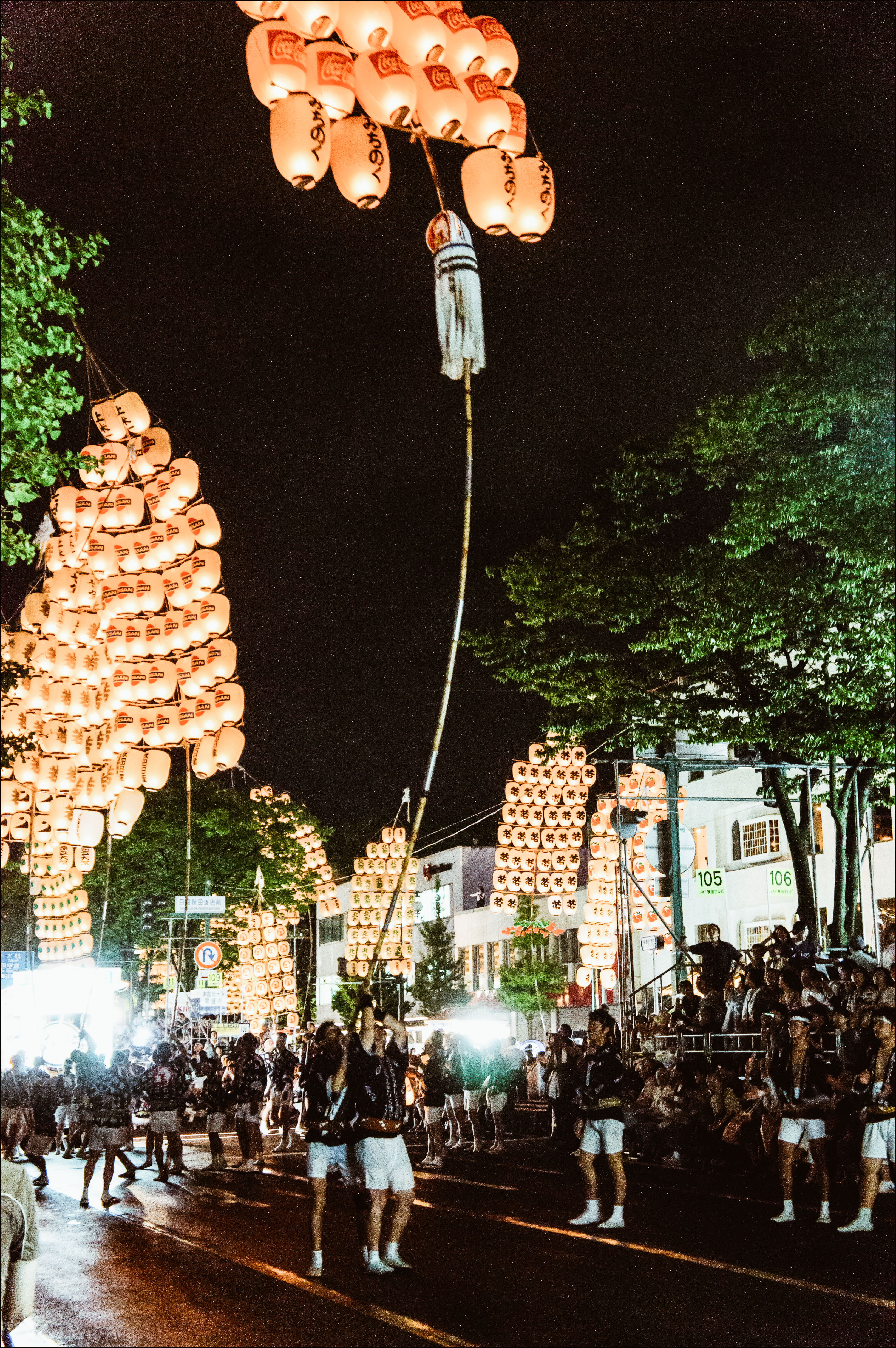

photo credits: Laura Tomàs Avellana
Kata (shoulder)
The artists hold the Kantō in the palm of their dominant hand and form a starting line from the leg to the Kantō, raising it even higher.
Hitai (forehead)
The artist holds the Kantō with his fingers and then moves it to the palm, then on the forehead.
During the day there are also competitions to test these skills, the Myogikai. The aim is not only to show their skills but also to study those of the other participants to learn new techniques.
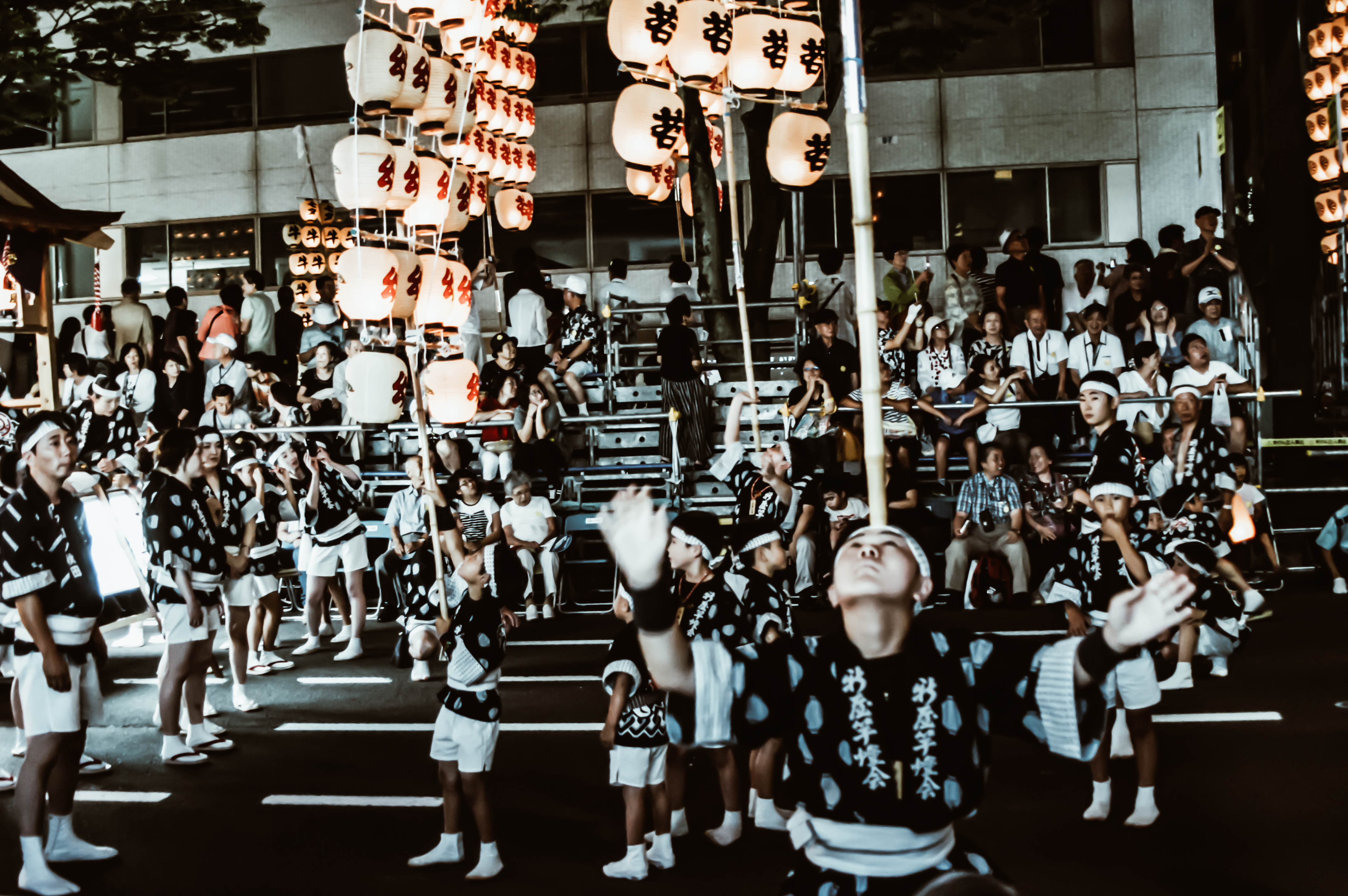

photo credits: foxeight
The Akita Kantō today
The date of the festival has been changed three times. It is currently held from 3 to 6 August each year.
The evening performance of the Akita Kantō is the main one and is held at the Kanto Oodori, one of the main streets of Akita. Here the purpose of the performers is not to compete with each other, but to entertain visitors by showing their skills and illuminating Kanto. More than 230 are raised at the same time to the sound of taiko music and flutes.


photo credits: foxeight
A unique experience of its kind that is worth living in full, as soon as you have the chance.
Bringing Japan to Italy: episode 08 - Alex Kerr
In conjunction with the release of his book "Lost Japan", Alex Kerr held a conference at the Palazzo Reale in Milan. We at Japan Italy Bridge had the opportunity to meet him and ask him some questions.
In this episode 8 of our Bringing Japan to Italy series, Alex Kerr tells us about his secret Japan. Son of an American navy family, from a young age he travels the world between Italy, Japan, USA, and then returns to the land of the Rising Sun. Since his college years, Alex Kerr has made Kyoto his life base.
Here he discovered a new world, a Japan that we Westerners can hardly see. A country made of traditions, small villages and thatched-roof houses with antique wood floors. He tells us how his life has changed thanks to winning the Scincho Gakugei literary prize. As a result, Alex Kerr came into contact with a group of Litterti and Japanese artists with whom he still collaborates today.
But now we leave you with the words of Alex Kerr and his secret Japan. Enjoy the video!
Special Thanks: Associazione Giappone in Italia
Lost Japan: Amazon US
Japan Tradition: Tenjin Matsuri
The Japanese summer is characterized by the famous matsuri, including the Tenjin Matsuri (天神祭) of which we speak today.


photo credits: Pic tures, jtabn99
Ranked as one of the three largest Matsuri in Japan, Tenjin Matsuri takes place in Osaka. It started in the 10th century, but today it takes place between 24 and 25 July each year. However, the major celebrations take place on the second day, including the procession along the river together with the fireworks display.
This particular festival is dedicated to the Tenmangu Temple and its main deity Sugawara Michizane, God of scolars. Like other famous matsuri (Gion Matsuri di Kyoto and Kanda Matsuri di Tokyo) also here the festivities begin in the temple.
Le festività


It all starts with the opening ceremony. Here the deity is invited to leave the temple and then a parade begins. The inhabitants of Osaka entertain the divinity with exuberant festivities, before bringing it back to the temple.
This becomes an opportunity for everyone to fully enjoy the hot days of summer. In fact, you can see people wearing traditional costumes and spectacular parades.
The Tenjin Matsuri in detail
As we have said, the Tenjin Matsuri takes place over two days. The first day, on the morning of July 24th, the festival begins at the Tenmangu Temple. Here people gather for a traditional ritual and then move on to pray by the river. The inhabitants of Osaka in this way in fact ask for prosperity and security for their city.
In the afternoon of the same day, the drums are played by men with big red hats. This serves to inform the population that preparations for the festival are complete.
However, the culmination of the celebrations takes place at 3.30 pm on the second day, July 25th. At this time, the drum players with red hats lead the procession.
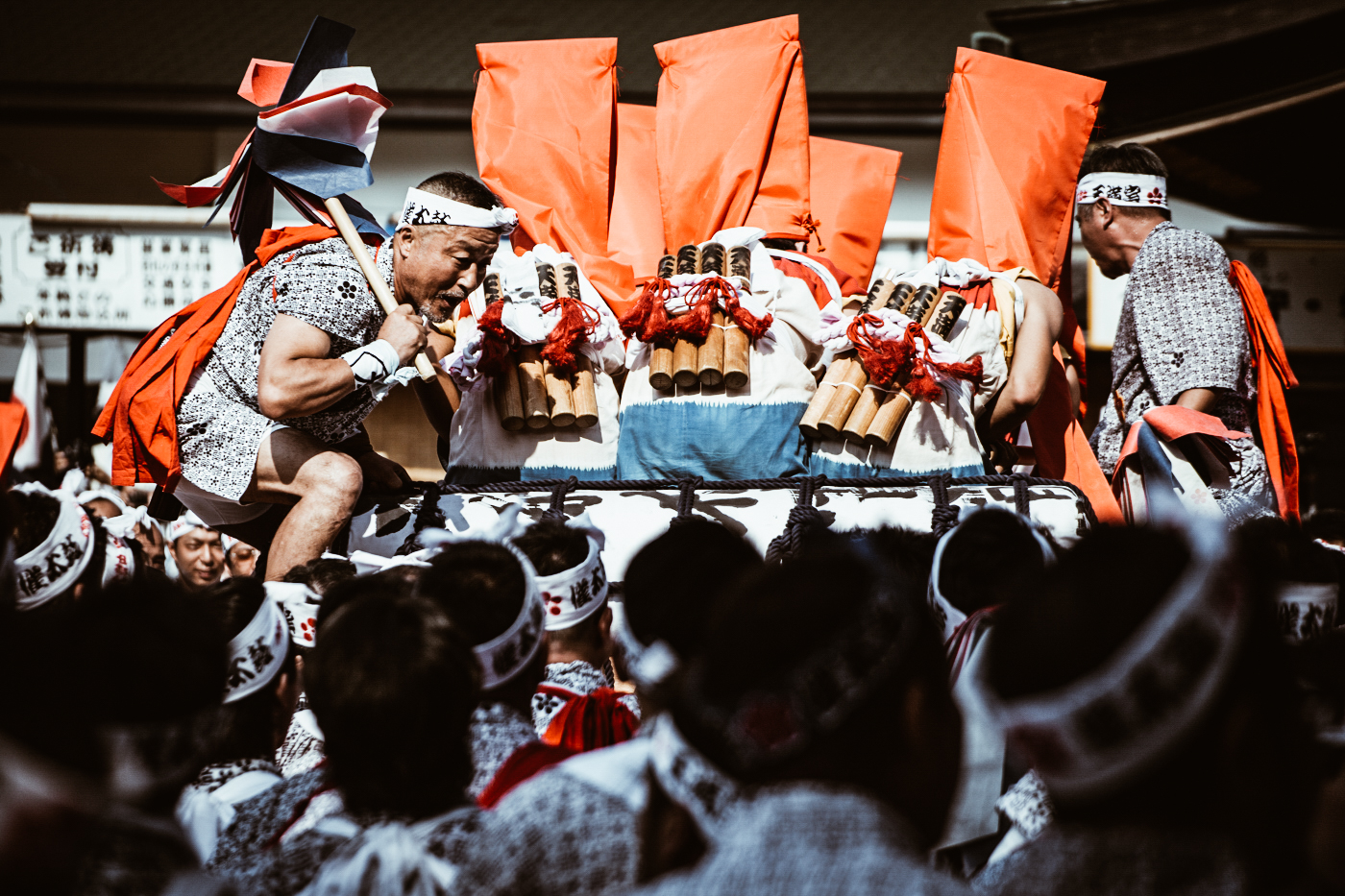
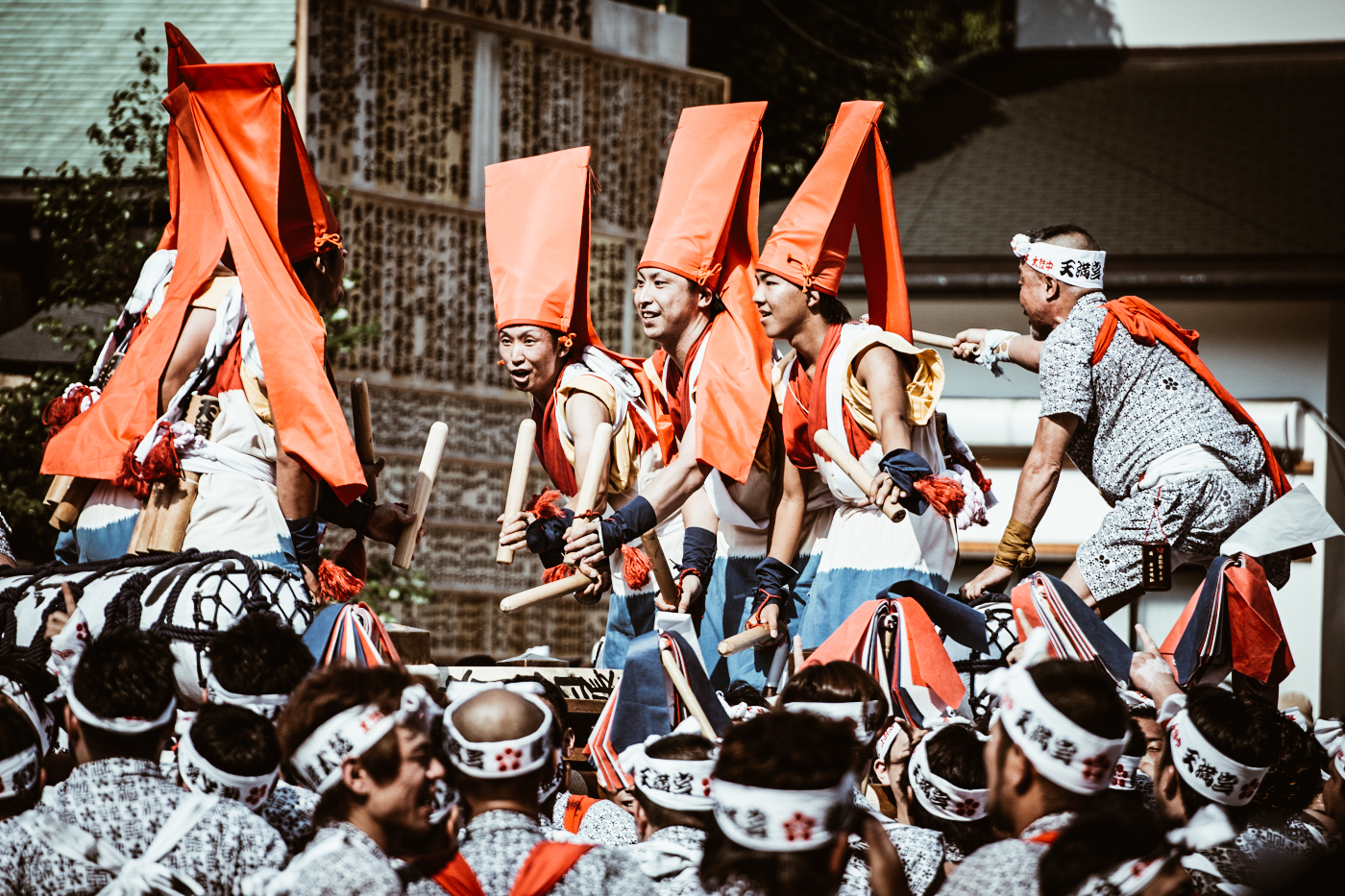
photo credits: hyossie
Starting from the Tenmangu Temple, the parade crosses the streets of Osaka. In this long procession, we find characteristic masks. We cannot fail to mention the Sarutahiko, a long-nosed goblin riding a horse. These masks are accompanied by inflatables, festival music, dancers of various kinds and other attractions.
An hour after the procession begins it is time for the mikoshi to leave the temple. This "portable temple" contains within it the deity Sugawara Michizane. On this occasion, the mikoshi follows a girl and a boy who have the task of guiding a sacred ox, the messenger of Michizane. During the parade other mikoshi appear, but if you want to see the one dedicated to Michizane, keep your eyes open for the temple with the phoenix.
At 6 pm, the parade arrives at the Okawa river. Here the people and the mikoshi are loaded onto the boats to continue the parade on the river.


photo credits: jtabn99, pasteis de nata
The Tenjin Matsuri and the "stage boats"
It is also possible to find "stage boats". In fact, on some of these boats, it is possible to watch performances of the traditional Noh and Bunraku theater. Moreover, in the midst of all these boats, you can also see the Dondoko, small boats that easily navigate the river thanks to young rowers.
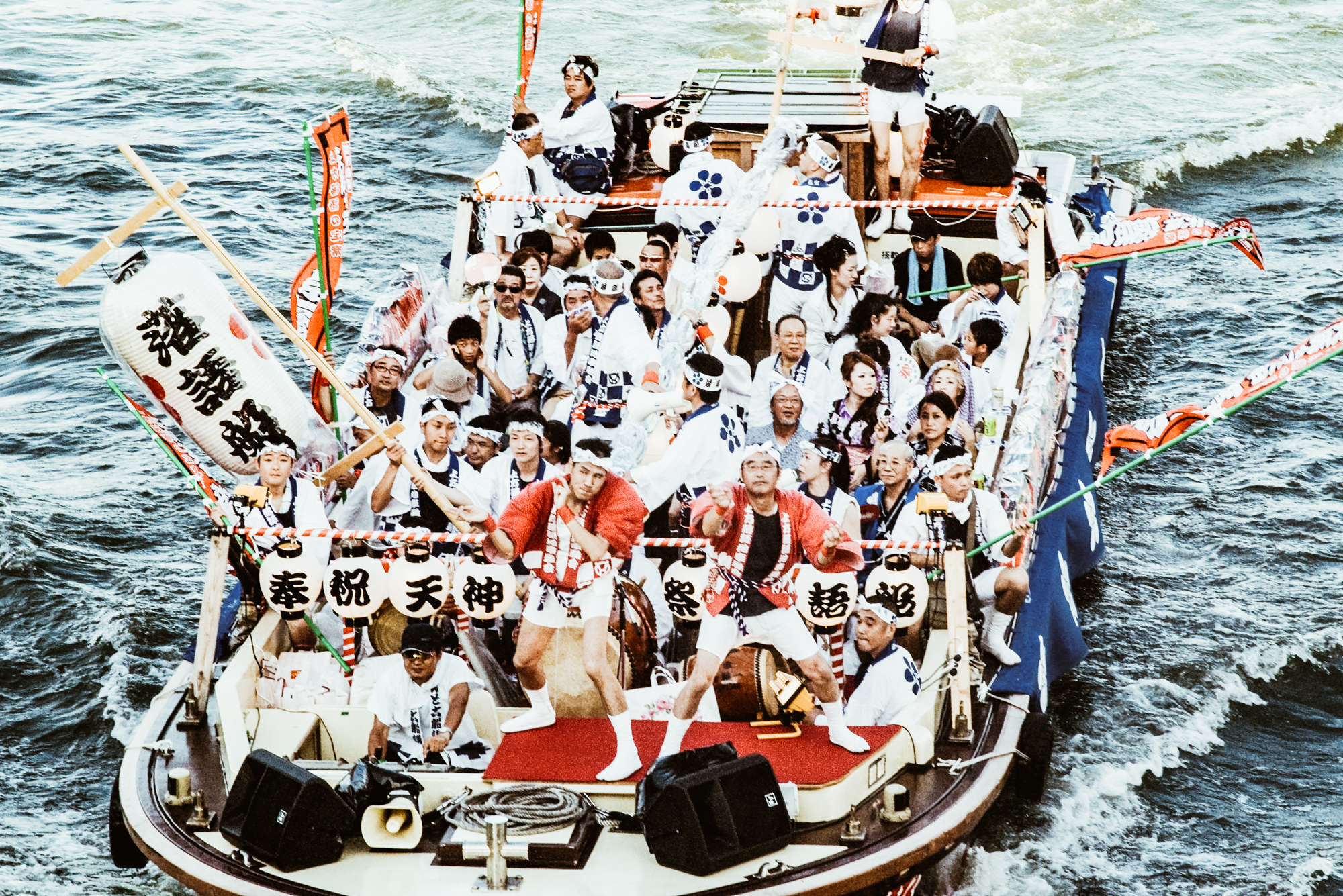
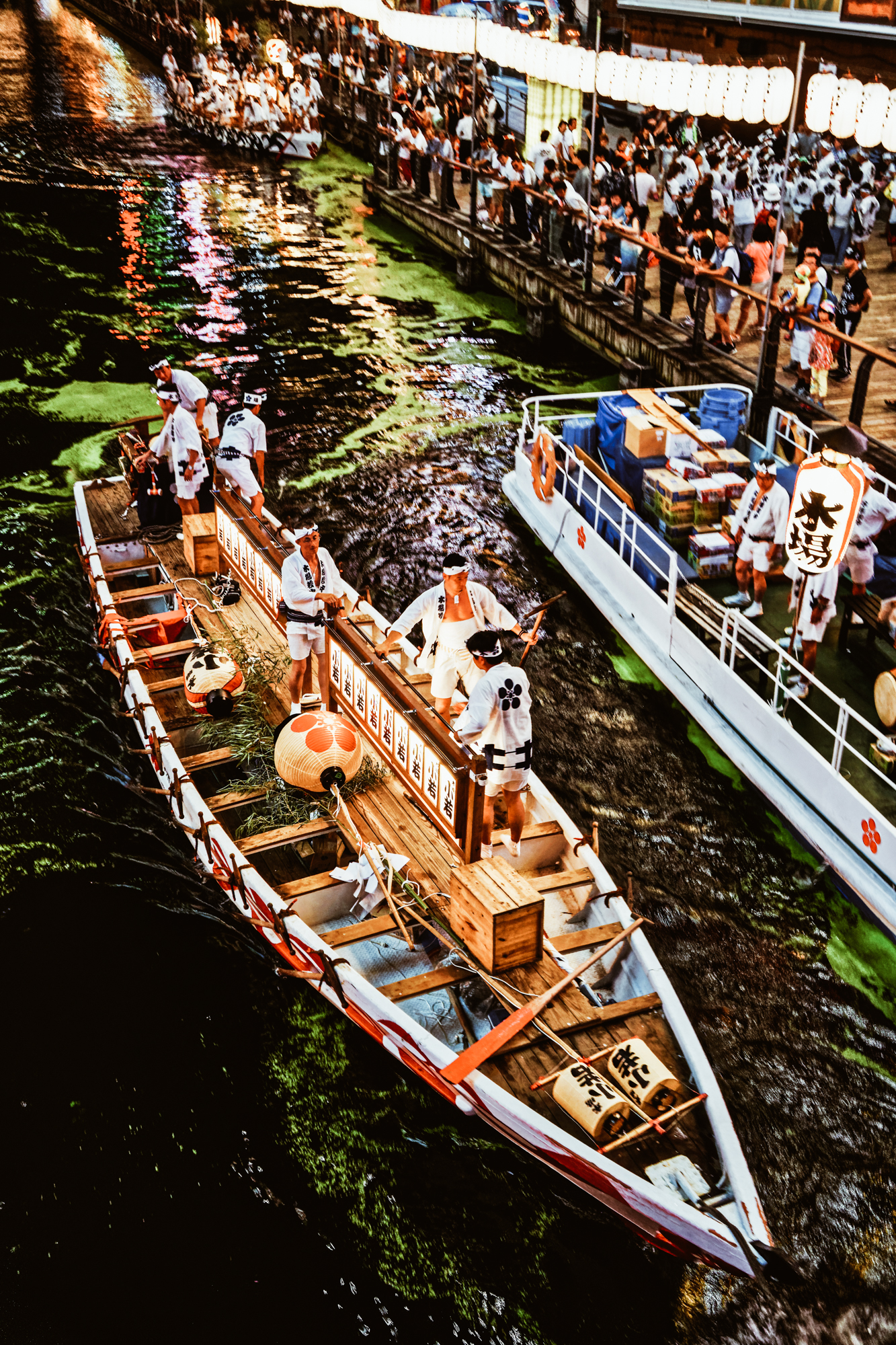
photo credits: elmimmo, wolf4max
We cannot then forget the endless delights of street food in Osaka, an extremely famous city for its food.
The procession continues while the celebrations go on during the evening. The climax is reached again from 19:30 to 21:00 when the fireworks show begins. Japan is known, it is famous for its fireworks show. However, those of the Tenjin Matsuri along with its illuminated ships reflecting on the river, offer a unique show of its kind.
After the end of the fireworks, the mikoshi land and return to the temple at 22:00, marking the end of the festival.
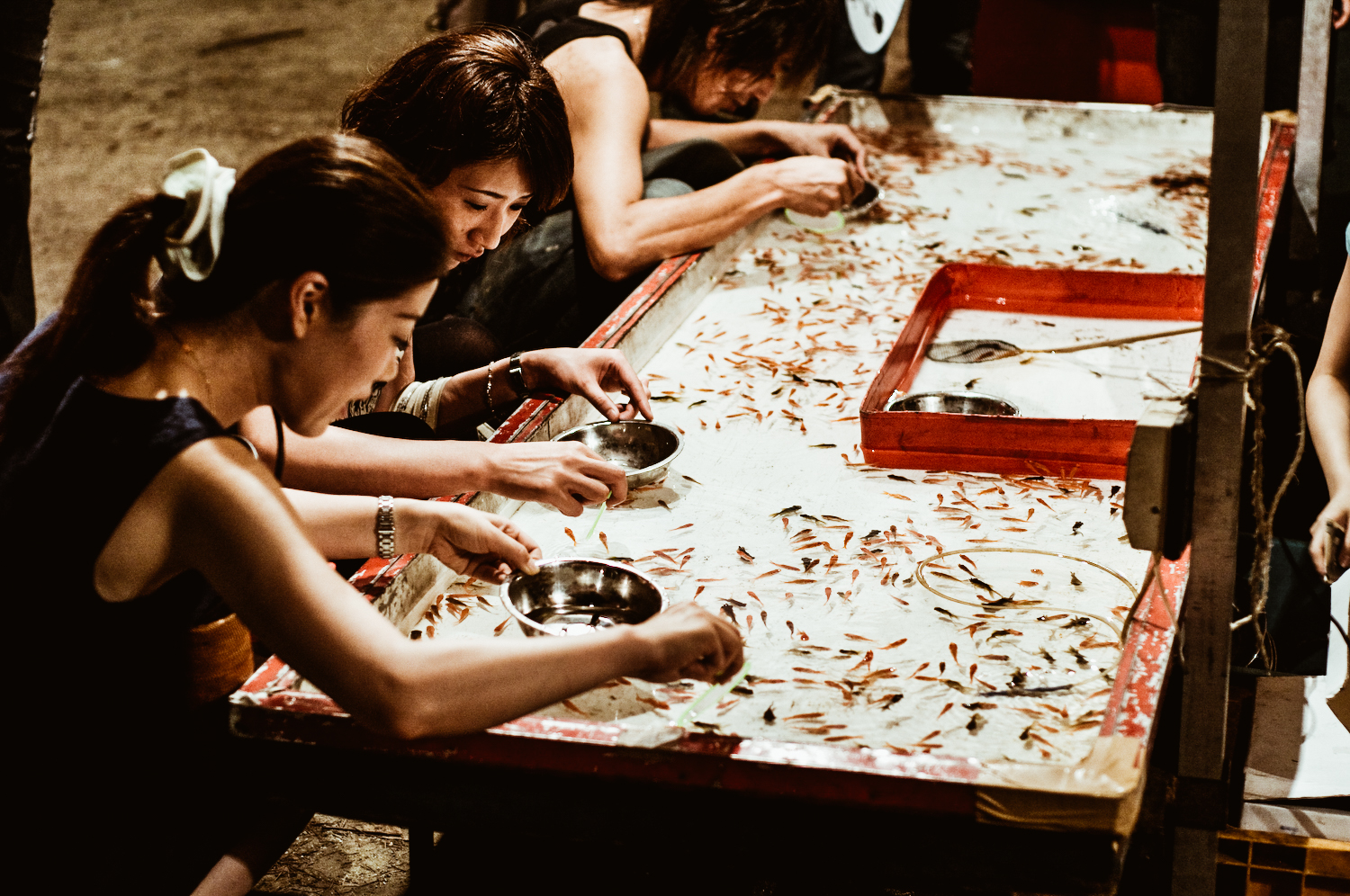


The turnout
Tenjin Matsuri is usually one of the busiest times of the year, especially along the banks of the river during the evening show. In fact, to watch the fireworks show it's really hard to find the right place to fully enjoy the show.
However, there is the possibility of purchasing tickets for seating located near Temmanbashi station. The cost is about ¥6000 and requires reservations in advance. This will allow you to have a good view of the procession but not a perfect view of the fireworks.

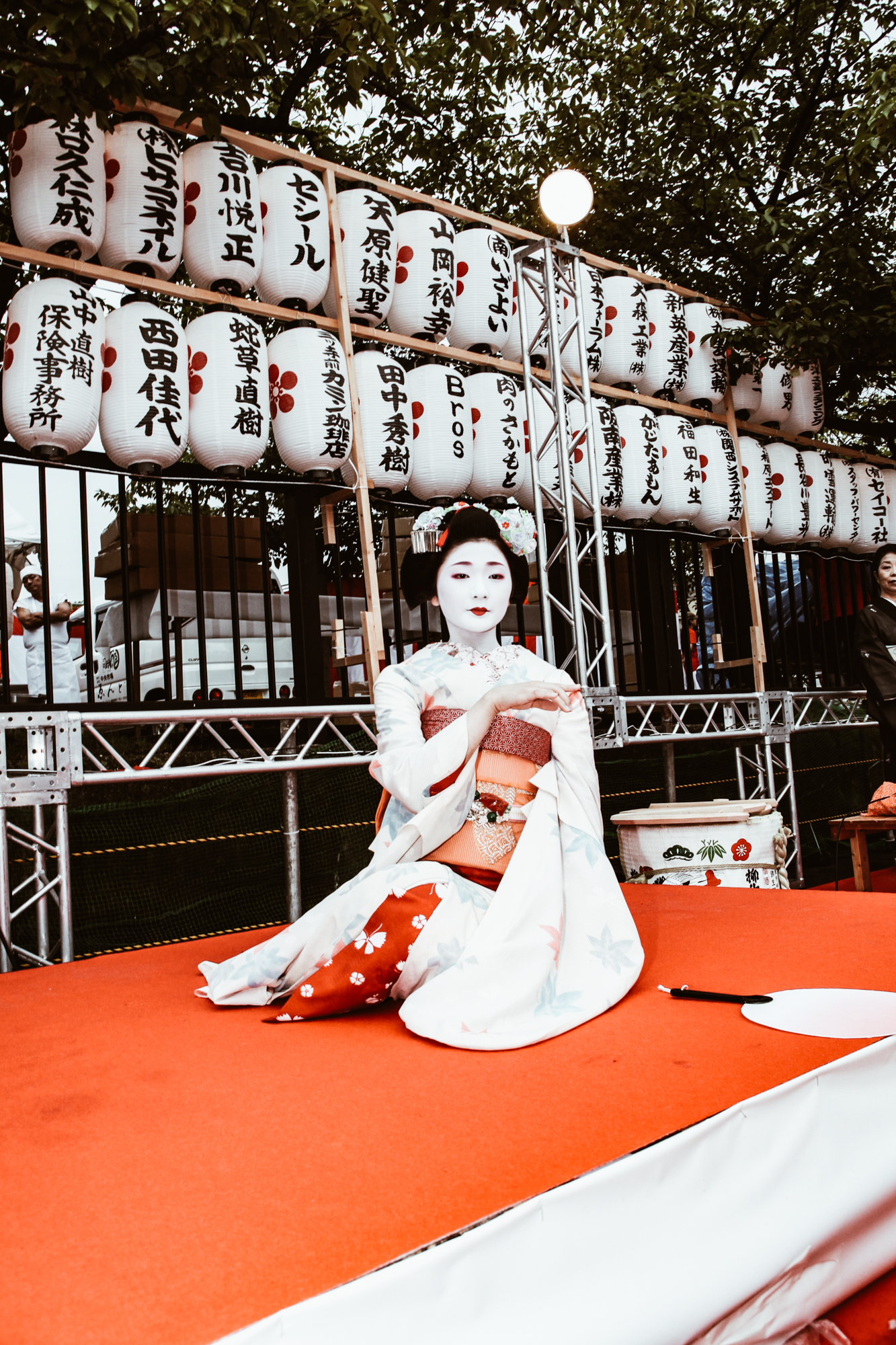
photo credits: japannewbie, Mi-Shin Shinoyama
The bridges along the Okawa River are closed during the parade and offer a privileged place as a viewing spot. However, visitors cannot stay long to ensure smooth traffic for all those present. Instead, the Kawasaki bridge is also closed to the public also because common people are not allowed to look at the temple deity from above.
The town decorated
During the Tenjin Matsuri, Osaka is decorated with thousands of colors, lights, torches, and lanterns all along the city center. A show not to be missed for both locals and tourists!
If you have witnessed past matsuri or are planning to attend the next one coming, let us know what you think!

photo credits: Laura Barrio
Bringing Japan to Italy: episode 07 - Yoko Takada
A few months ago, in conjunction with the Novegro comics festival, we had the opportunity to interview Yoko Takada. For this seventh episode of 『Bringing Japan to Italy』, the artist specializing in Japanese culture, tea ceremonies, Kimono dressing and much more speaks to our microphones.
Yoko Takada has kindly granted this exclusive interview for Japan Italy Bridge to help promote and share more the Japanese culture. Furthermore, we talk about the similarities between Japan and Italy, and why the bow is so important in the land of the rising sun. Did you know that? Enjoy the video!








